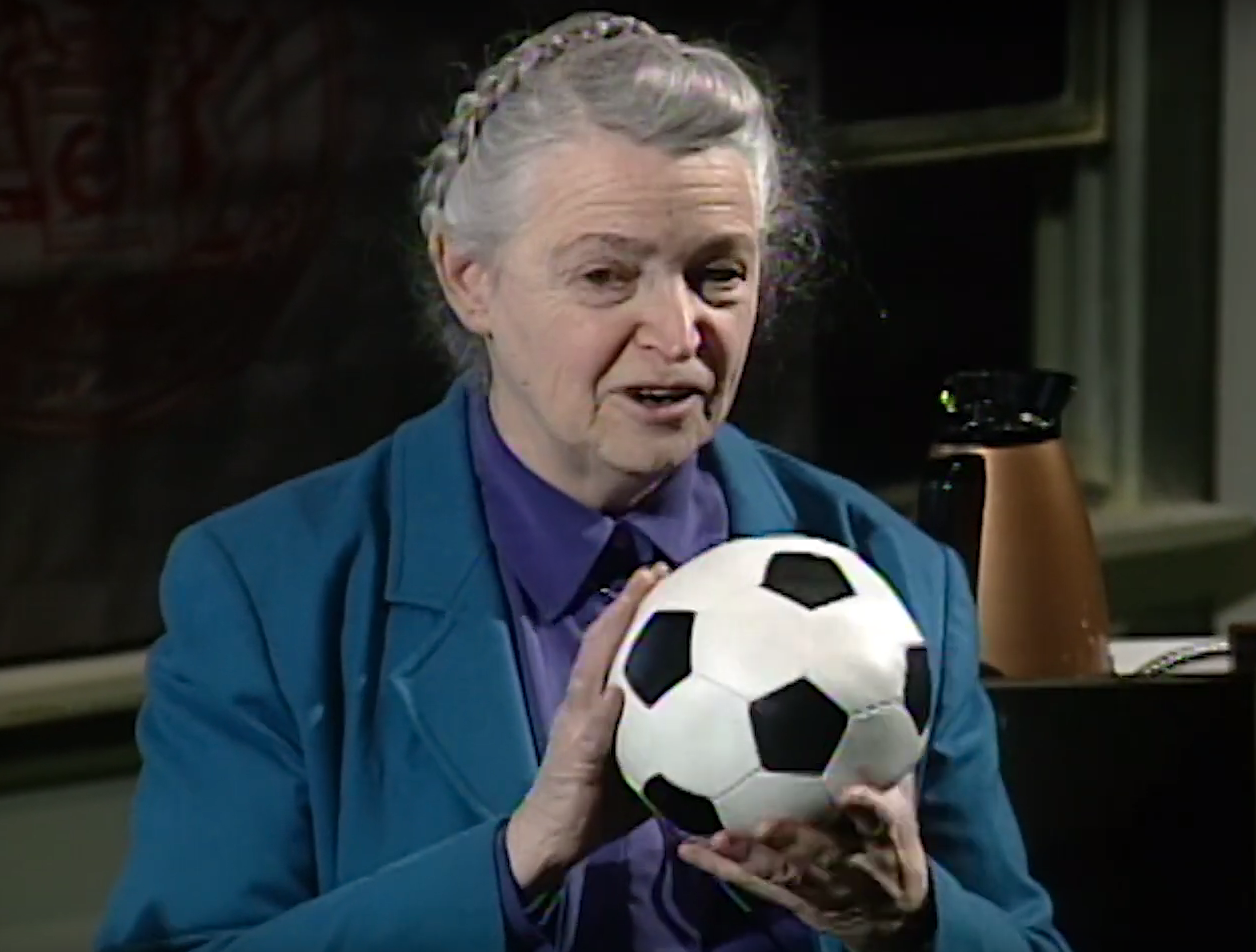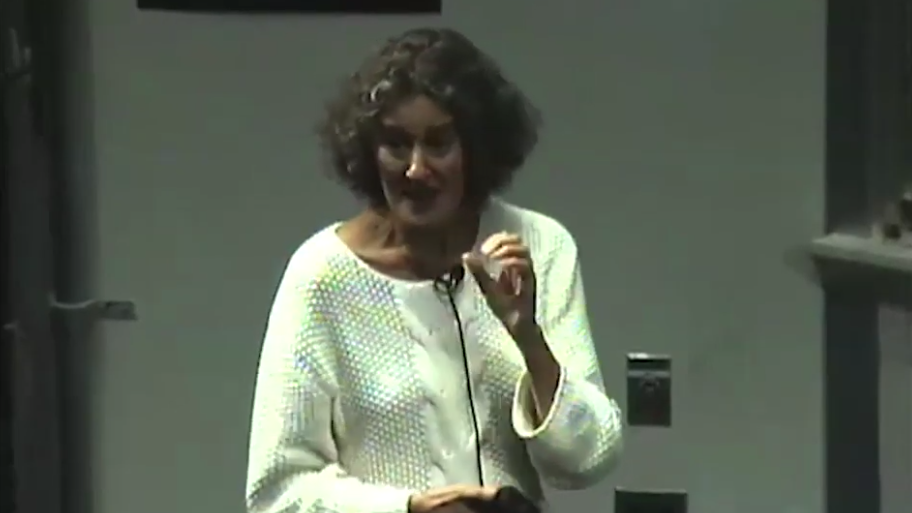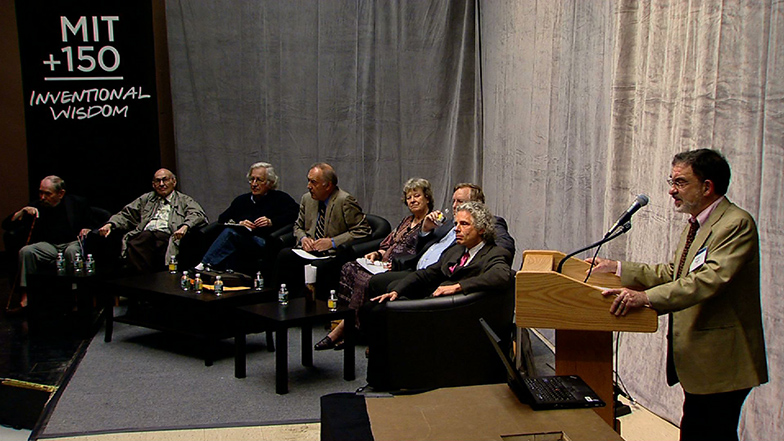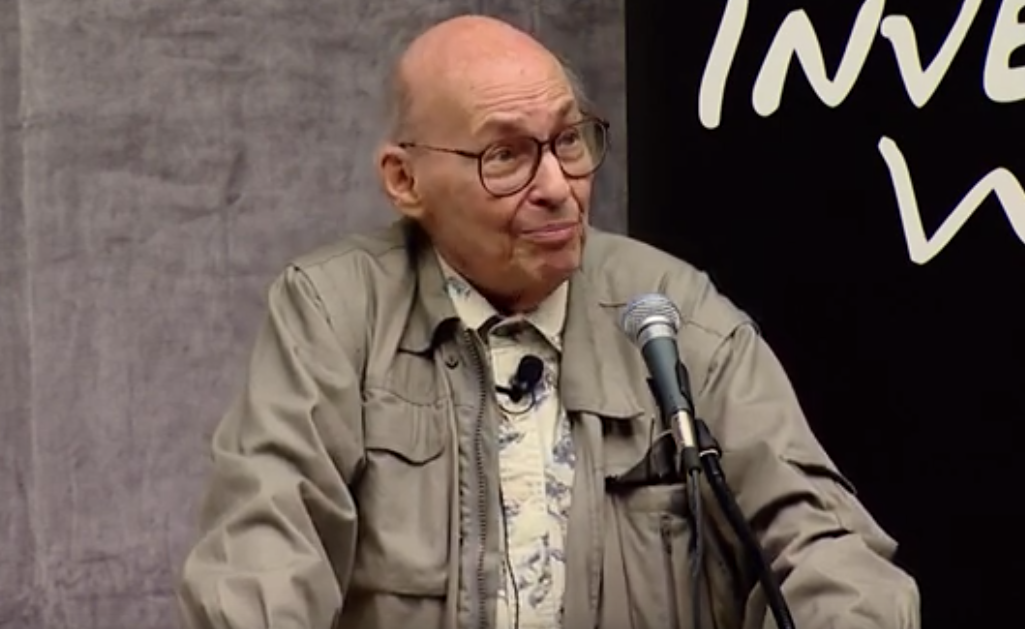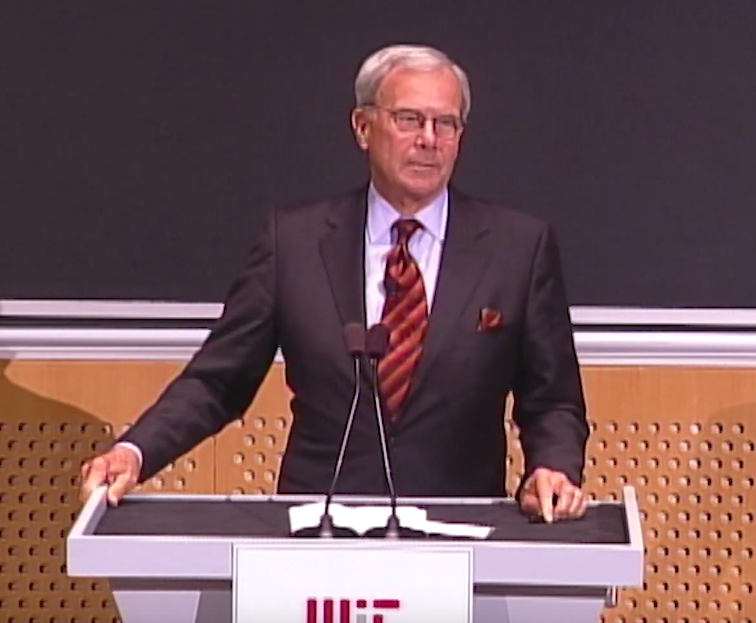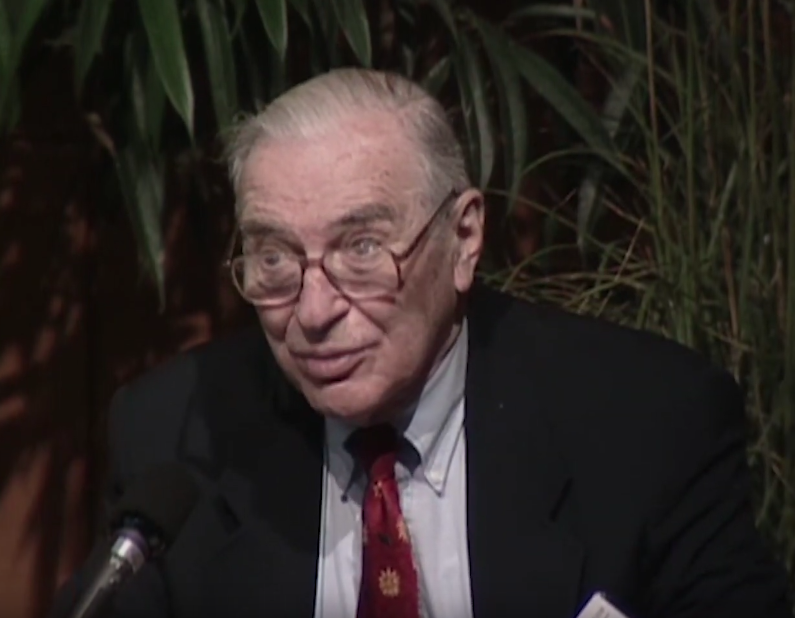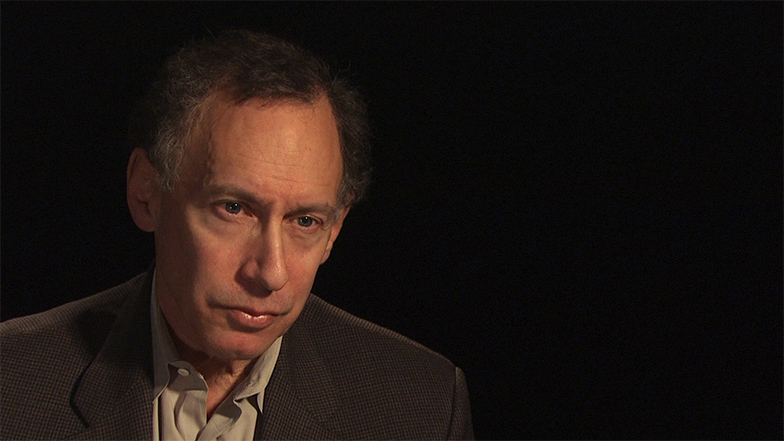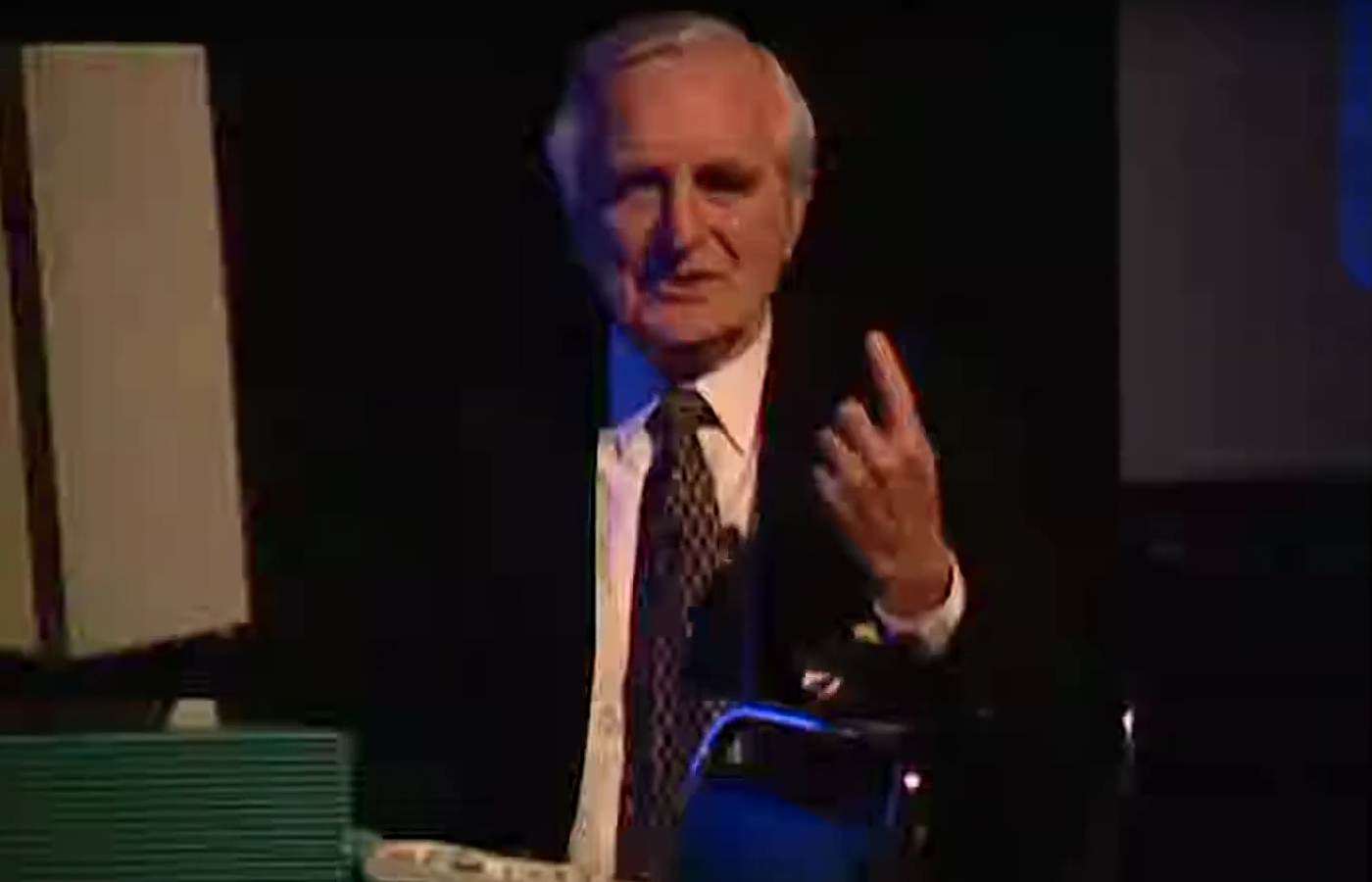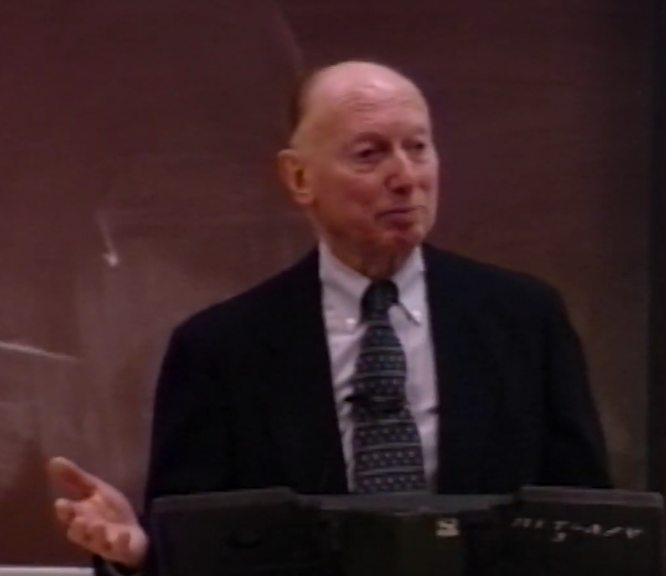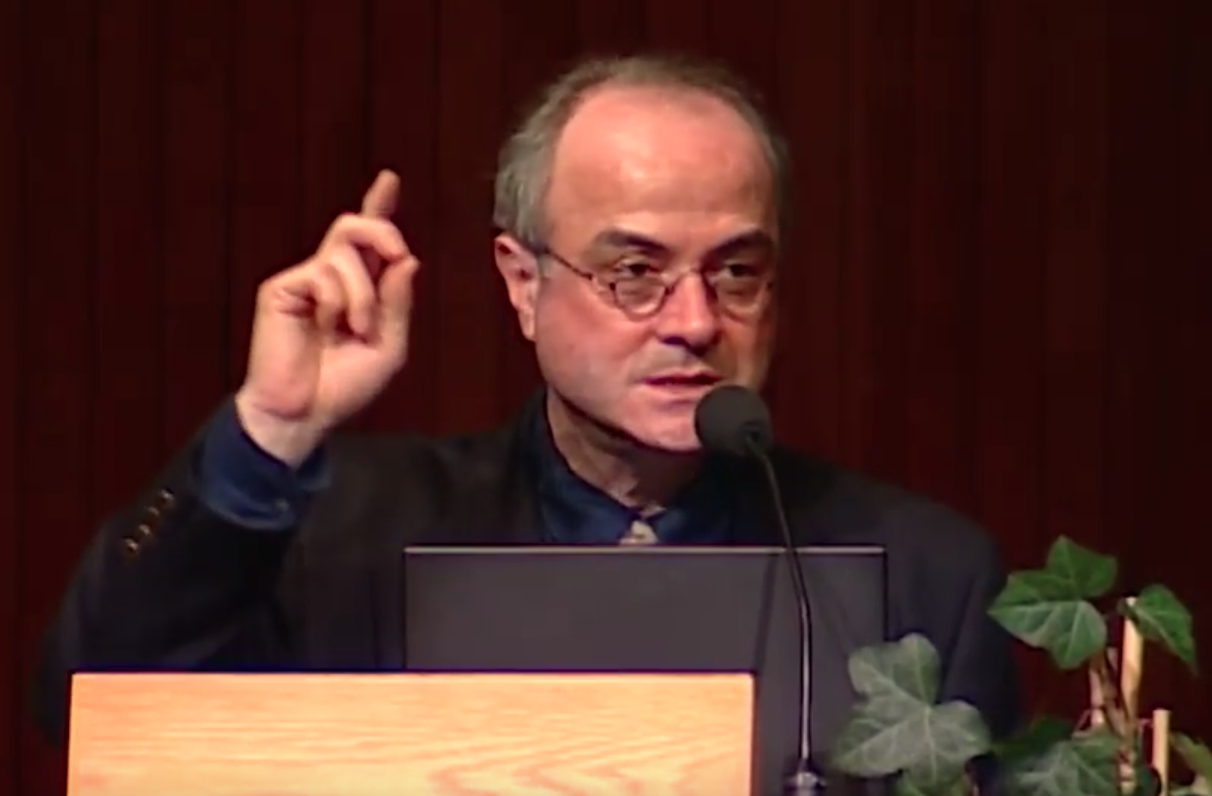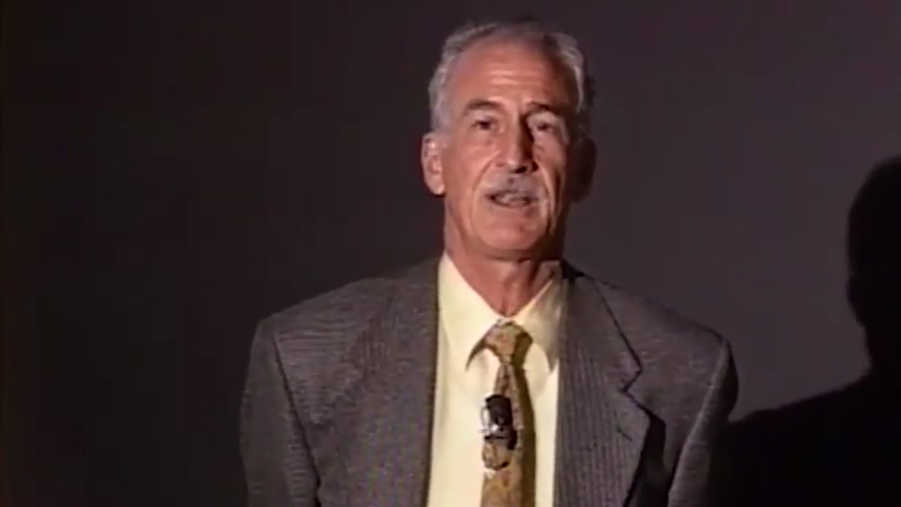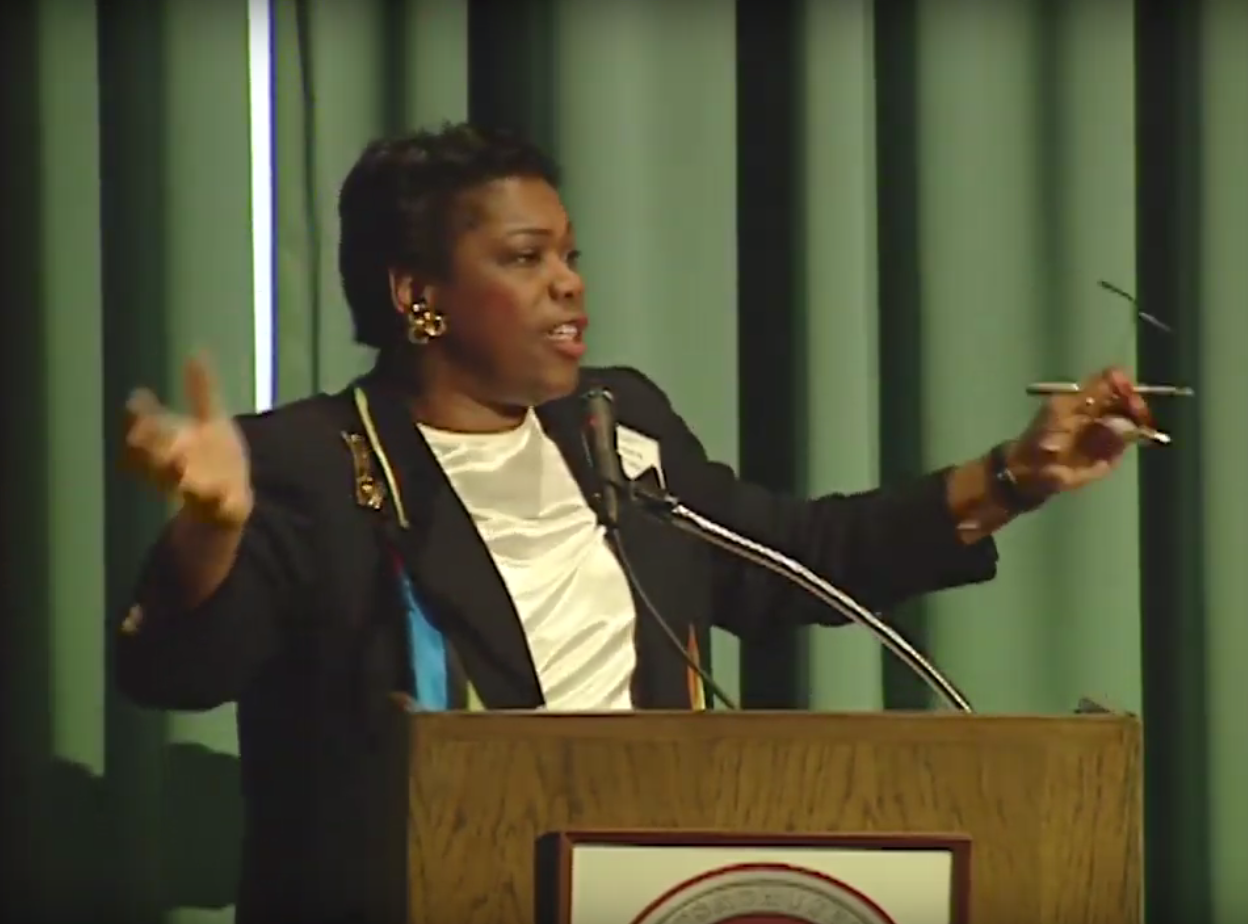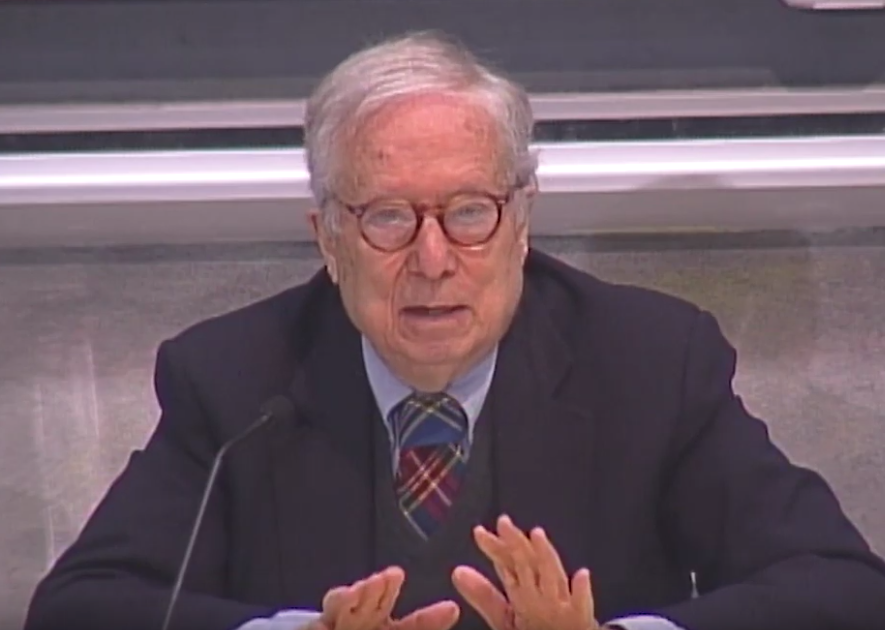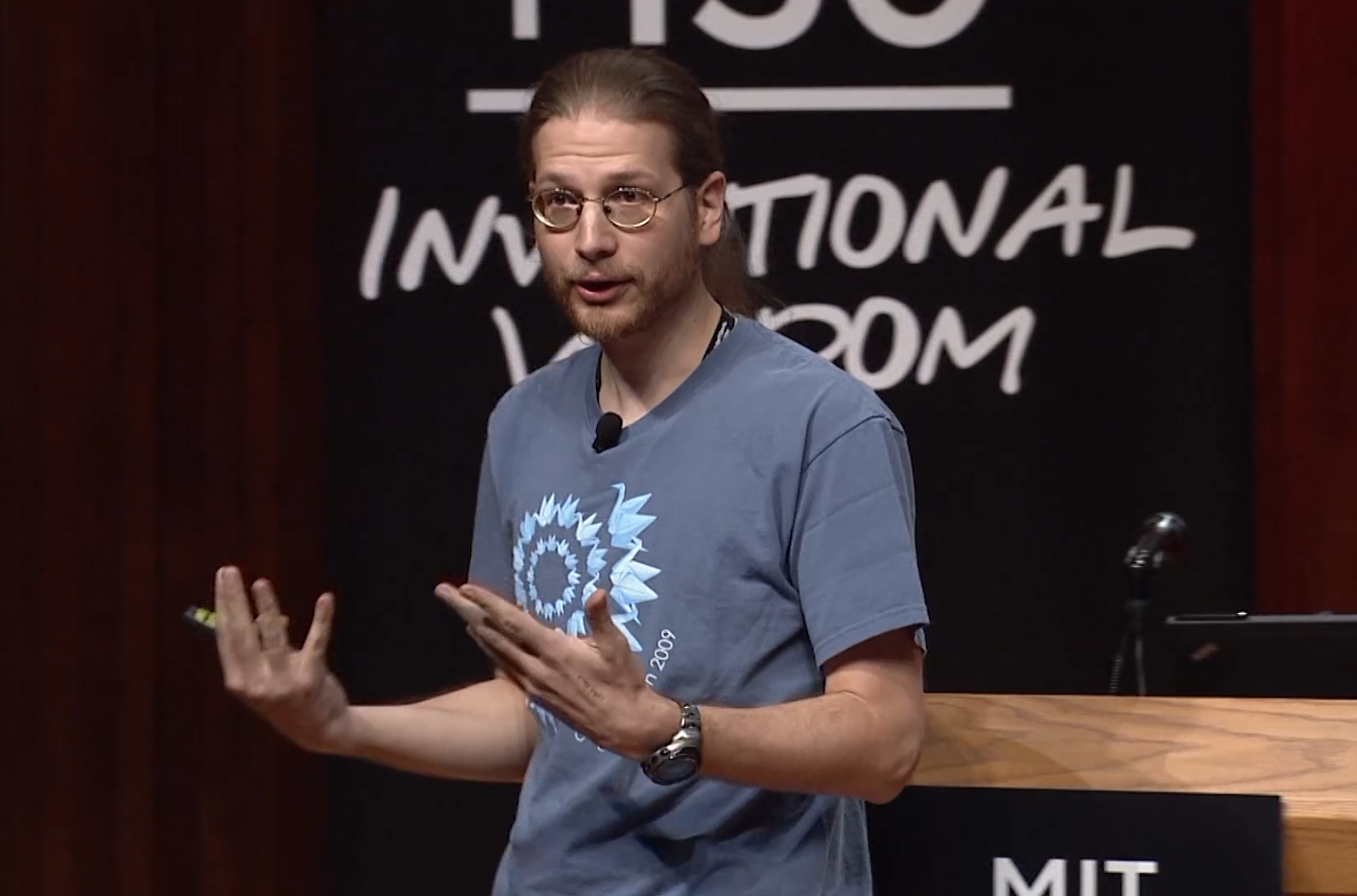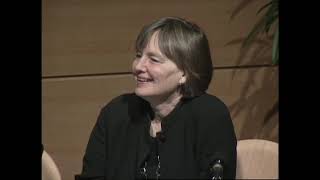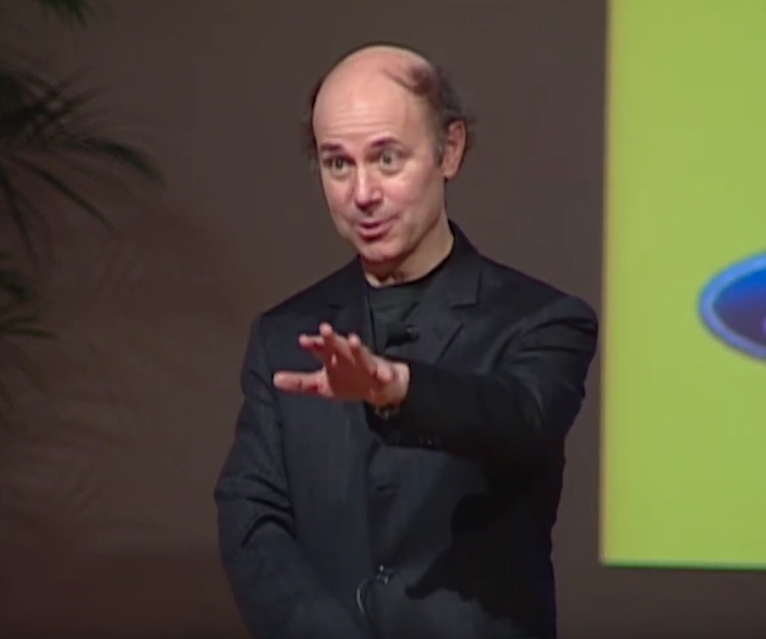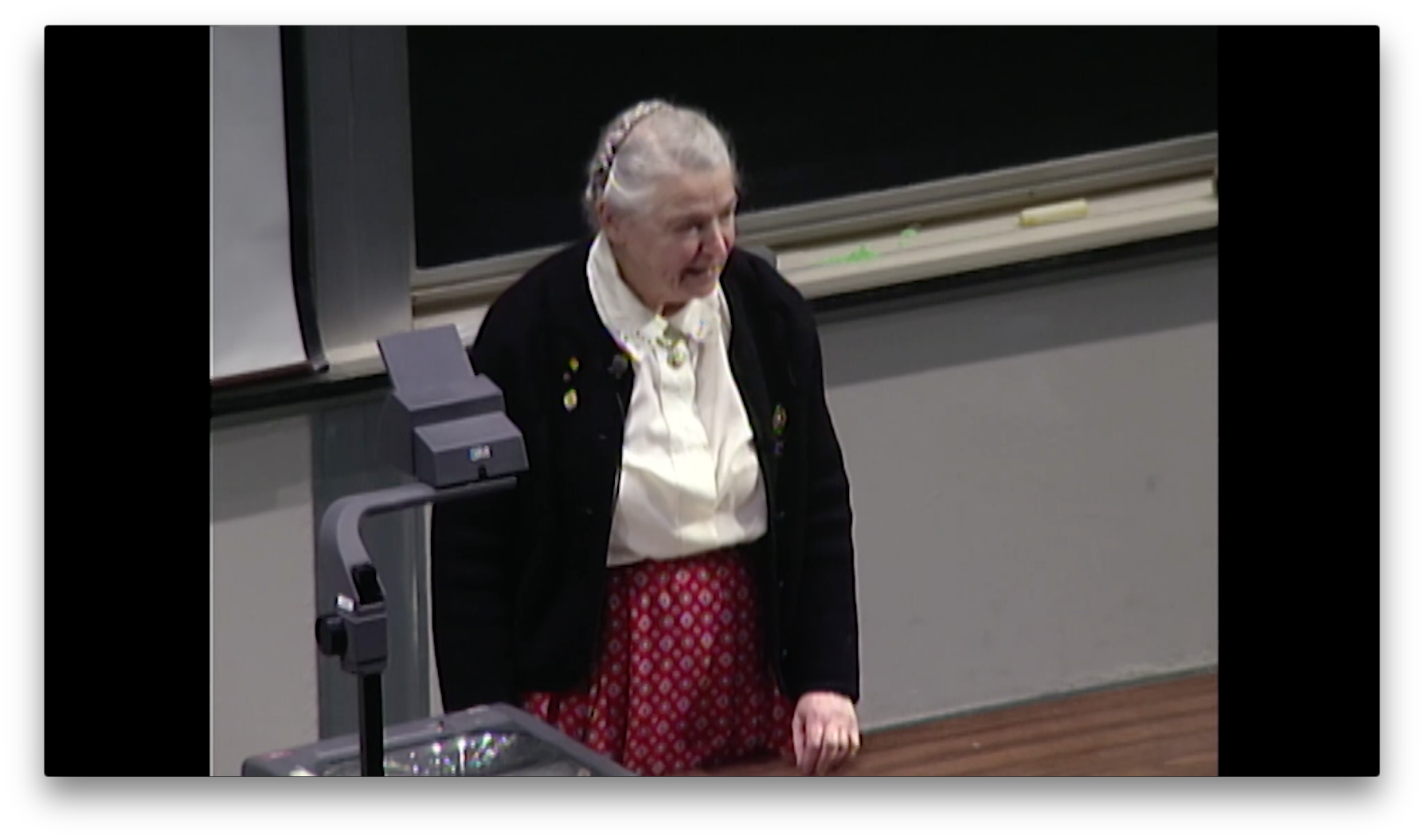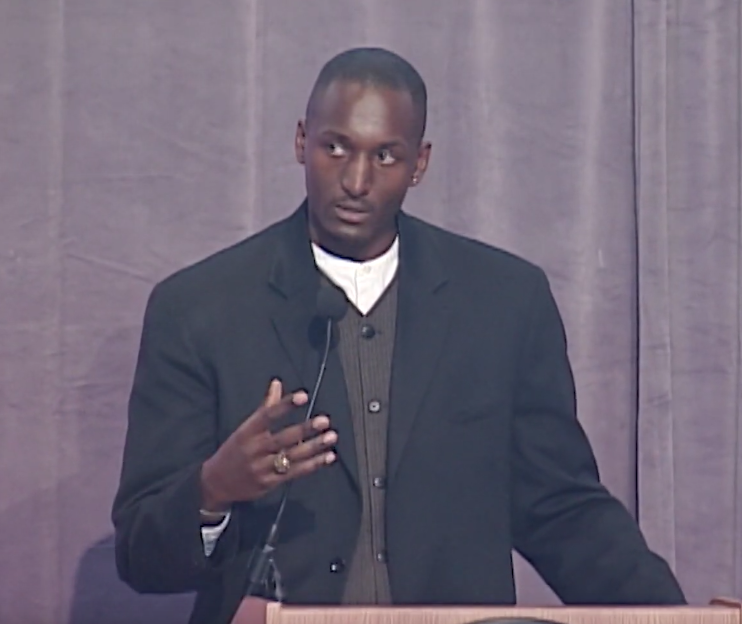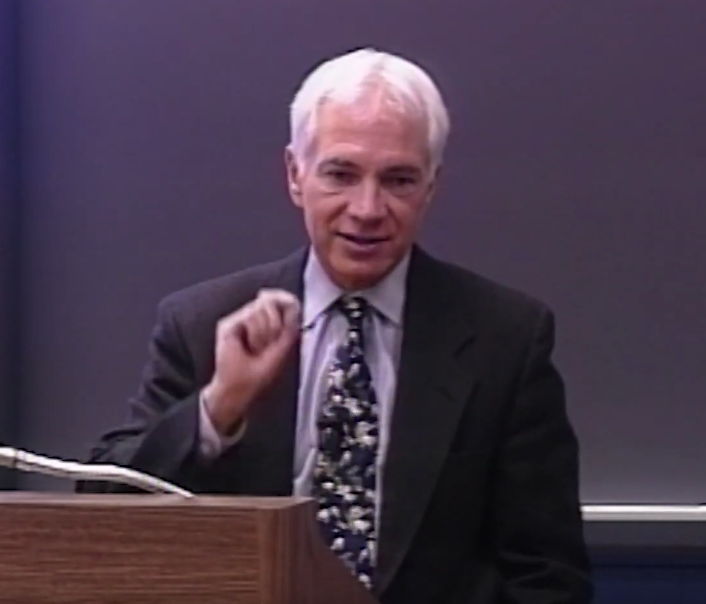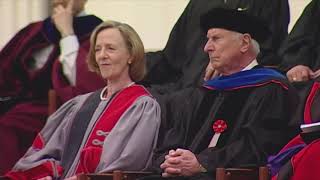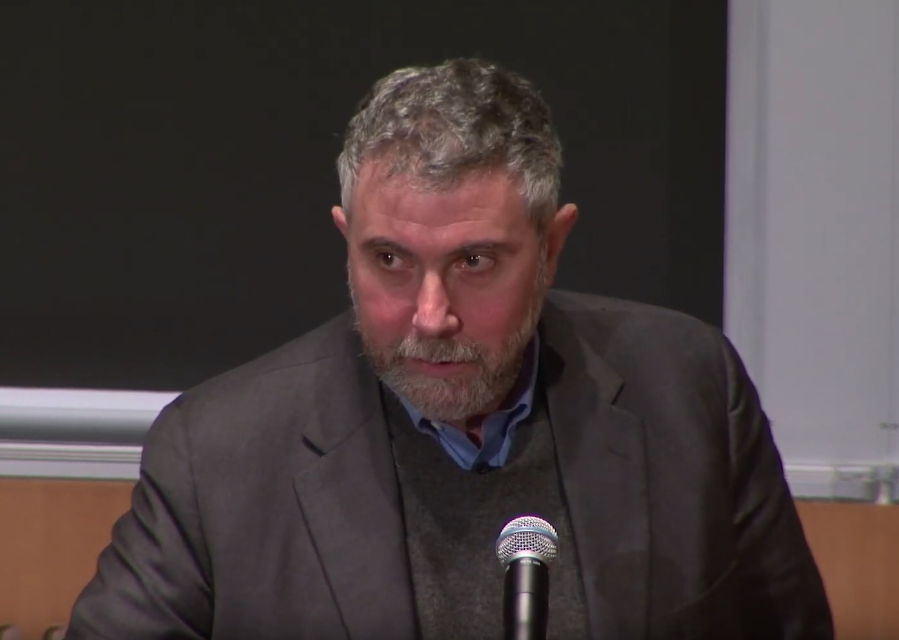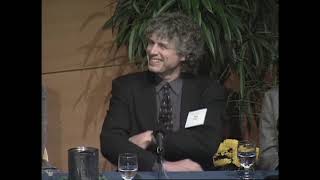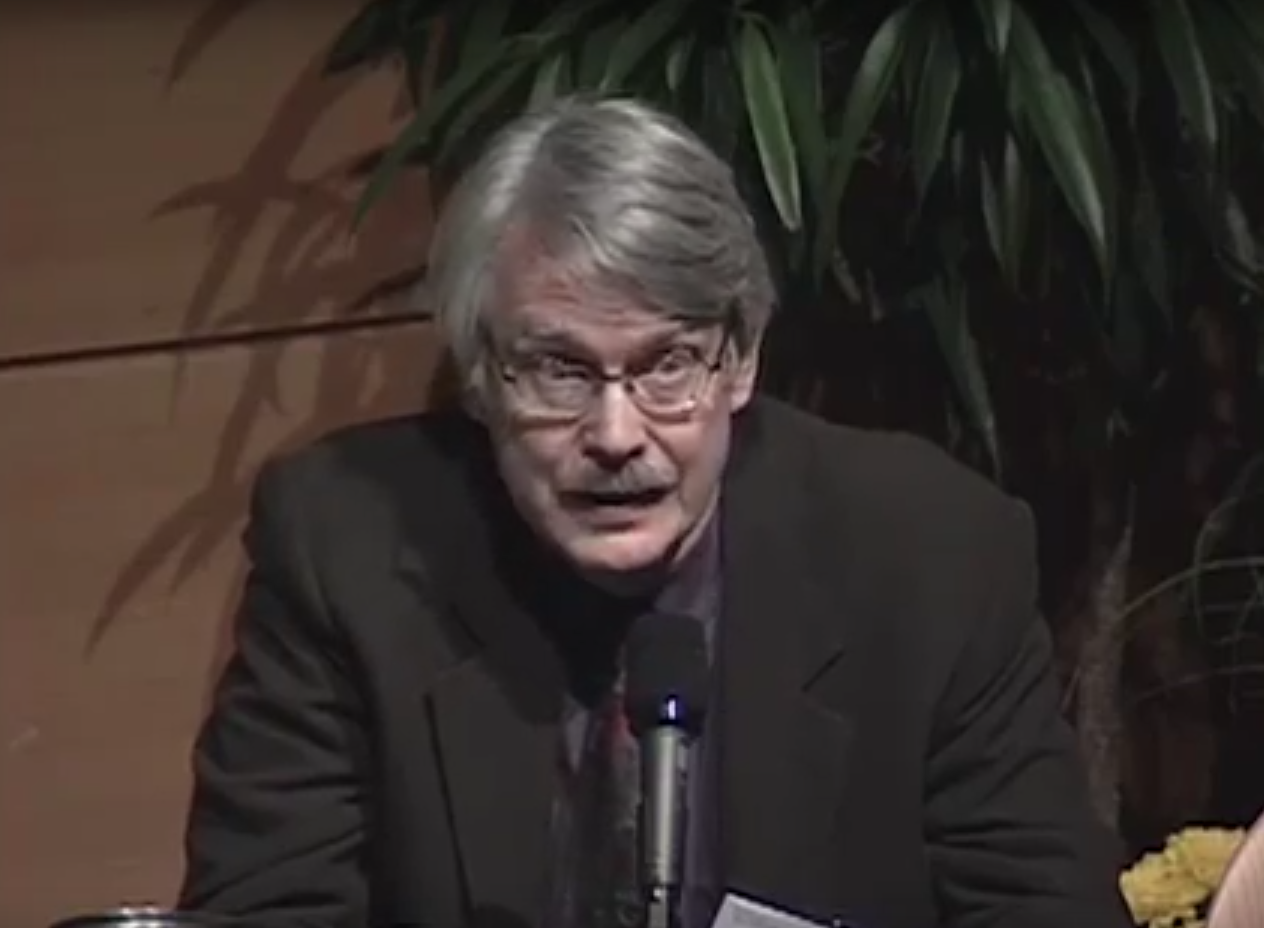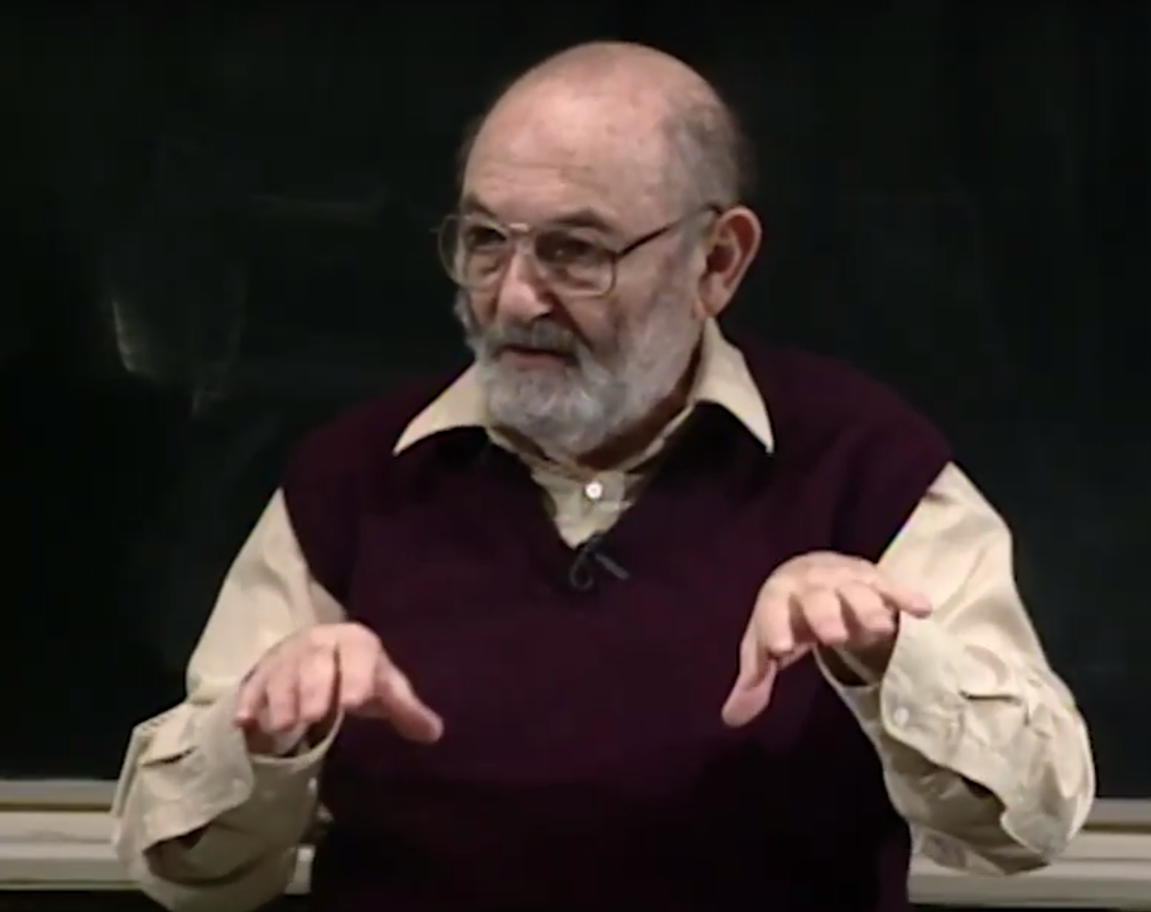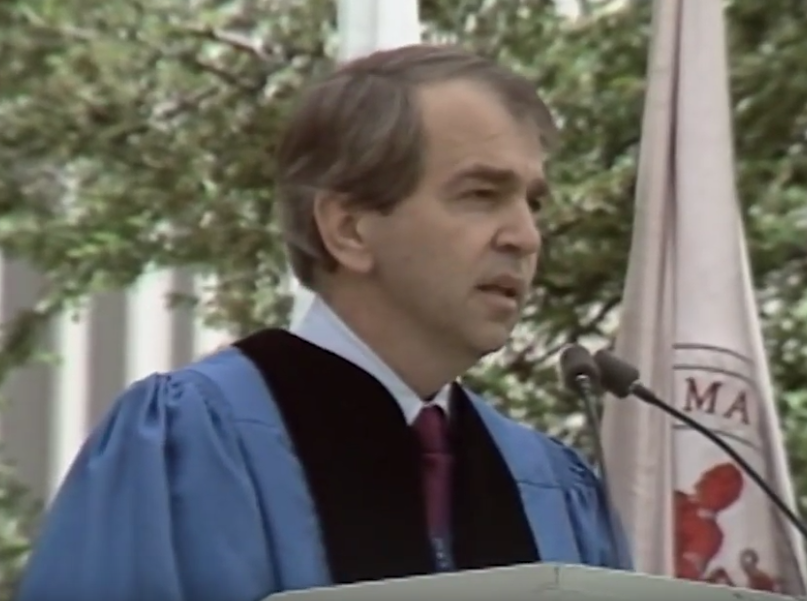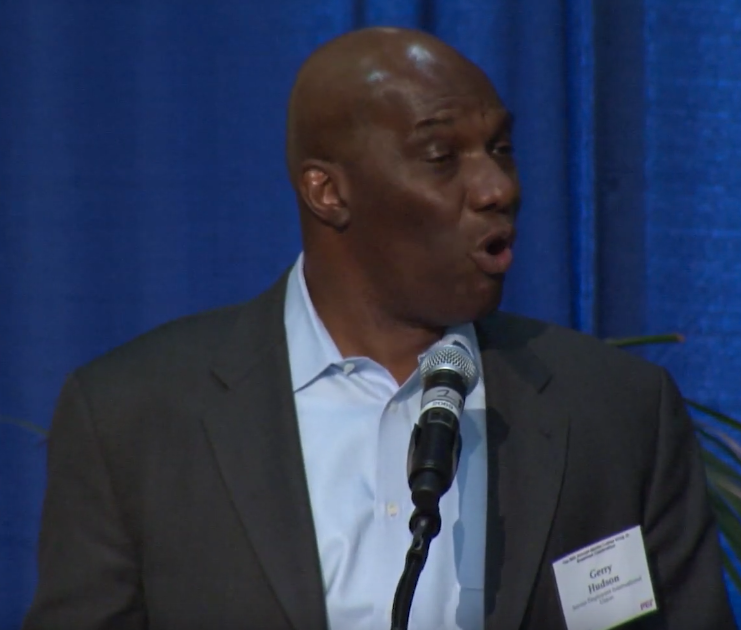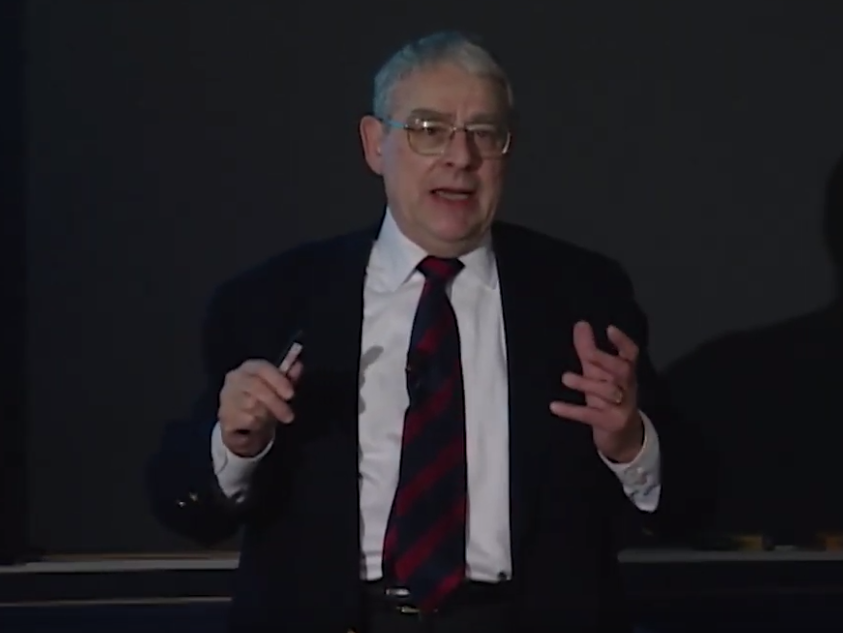Susan Sontag, E. O. Wilson & Roger Penrose at MIT - Images & Meaning Conference 2001
[MUSIC PLAYING]
[BACKGROUND CHATTER]
ANNOUNCER: Ladies and gentlemen, please welcome Roger Penrose, Susan Sontag, Edward O. Wilson, and Alan Lightman.
[APPLAUSE]
LIGHTMAN: I'll sit here. Welcome to our evening discussion of image and meaning. I'm Alan Lightman of MIT, and it is my pleasure and privilege to be the host of tonight's session. In the history of modern science, a central measure of progress has been the degree to which knowledge can be expressed in numbers and equations and concepts. A ball takes 1.3 seconds to fall a distance of 30 feet. The electrical force between two electrons varies as the square of the distance between them. The energy of a closed system is always the same.
To represent a concept or a result in this form has usually been considered the most precise form of understanding nature. But knowledge can also be presented and misrepresented in pictures and images. Our minds and imaginations react to these representations in a different way than to numbers and equations. And here, we must remember that we can objectify and distill all that we want, but meaning and understanding must ultimately be assigned by the human mind. Image and meaning is really a matter of human perception.
We're sitting here tonight in one of the world's temples of science and technology, dedicated to the study of physical phenomena, atoms and molecules, DNA, computers, galaxies. But of all the wonderful mysteries of nature, nothing is more mysterious or profound than the human mind. Somehow, we are aware of ourselves and our relationship to the outside world. Somehow, we think. Somehow, we assign meaning to the billions of sensory inputs constantly flooding our brains. Somehow, we create new ideas.
More specifically, in the context of our gathering tonight and our conference topic of image and meaning, I want to raise the following four questions. What role do images and visualization play in the creative process? How do images change the way that we think of ourselves? How do images help scientists in their research beyond the help provided by numerical data? And finally, in what ways do scientists communicate their work? In what ways do images help scientists communicate their work to non-scientists?
To stimulate our thought tonight about these and related questions, we have with us three of the most interesting minds of our time-- Roger Penrose, Susan Sontag, and Edward O. Wilson. Roger Penrose is a mathematician and physicist at Oxford. In the 1960s, Penrose proved very general conditions under which the universe had to have originated in a big bang. Penrose often uses pictures and diagrams in his work. He is renowned for his discovery of Penrose tiles, which are two geometric shapes that can completely cover an infinite plane without ever repeating a pattern.
In his book The Emperor's New Mind, Penrose broadened his interests to consider the nature of thinking and human consciousness. Among his many awards, Penrose has won the Wolf Prize, which he shared with Stephen Hawking in 1988. And I learned tonight that a collection of Roger's drawings will be shown in the Ruskin School of Fine Arts at Oxford.
Susan Sontag is one of the great literary and cultural voices of America. In both fiction and nonfiction, she explores topics ranging from the American consciousness and identity, to the cultural and literary meaning of illness, to the different complexions of the narrative voice in the modern novel. Her nonfiction includes such books as Against Interpretation and Other Essays, Illness as Metaphor, and Under the Sign of Saturn. And her novels include The Benefactor, Death Kit, The Volcano Lover, and, most recently, In America. Sontag is a winner of the National Book Award and the National Book Critics Circle Award, and just recently, she has won the prestigious Jerusalem International Book Award.
Edward O. Wilson is an evolutionary biologist and zoologist at Harvard. Wilson is equally famous for his decades-long, detailed study of the tiny ant and his broad analyses and theories about the biological principles that govern social behavior and organization in all kinds of animals, including us. Some of Wilson's many books include The Ants, On Human Nature, and Sociobiology. One of his most recent books, Consilience, concerns commonalities between all forms of human knowledge.
Wilson, among his other awards, has twice won the Pulitzer Prize. And I learned from him tonight that he is at work on another book on what of all subjects but ants. 800 pages, including over 5,000 of his own drawings of ants.
I want to begin by giving a brief summary of the format for the evening. We will start with a series of six images, which you will all see here on the screen, and I hope that our panelists can see here pr by straining your neck and looking backwards. These are images which have not been shown before to our guests. Each of our guests will then speak for 10 minutes, during which he or she--
[LAUGHTER]
Is something happening? OK. All right, let me know when something happens.
Each of our guests will then speak for about 10 minutes, in which he or she can either give a spontaneous reaction to the images, or address the four questions that I brought up earlier, or speak on any topic that is relevant--
[LAUGHTER]
--to our conference. Then, we'll have about 20 minutes of dialogue between the three of them, in which they can talk to each other. I may insert a question or two. And after that, I'll open the floor for questions and comments for another half hour. So, are you ready to have some fun? Good. Well, let's begin with the images.
Roger, can we start with you?
PENROSE: OK. Well, let me comment first on your images here. I mean, the first one, presumably, is an atomic bomb explosion, which I take to represent the issue of science and the responsibility that one has in developing, in this case, nuclear energy. I'm certainly one of those people who believes that you can't really-- I mean, some people think that science, OK, that's a pure activity. You can do it. You don't have to worry about the social consequences.
I mean, there's something in me which believes that, too, that science is something that should be done for its own sake. But on the other hand, it does seem to me that the scientists, after all, are the people who have the best knowledge of what their discoveries are likely to do. And so, therefore, they do have a responsibility to at least pay attention to these issues. So I'm certainly one of these people who believes that you can't really separate the pure science from what potential applications it might have and whether they'll be useful for benefits or otherwise.
Of course, scientists are not always very accurate in their predictions in this way. And I think there's some famous quote from Rutherford, who thought that nuclear energy would never be useful for anything. So you can't always believe what they say. But on the other hand, they are in a better position than other people. So the responsibility is there.
I take the second image to be representative-- well, it certainly is the Earth rising from the moon. And it does represent a fantastic achievement, a technological achievement. Not so much as scientific achievement, although there is, of course, that. It goes back to Newton. One appreciates that space travel was potentially possible. But it's really a technological achievement, which required a great deal of money and so on.
And I feel a great thrill in this. I was one of these people who stayed up all night when the first moon landings came out and so on. I think it's a great thing that people can do this. Of course, they're not doing it now, but maybe they'll go to Mars one day. And so I like that kind of thing. I think it's great. But it is expensive, of course, and one has to worry about how these things affect other research which might be going on.
Here we have Crick and Watson, and of course, this was a fantastic thing they did to discover the structure of DNA, and it did set off a tremendous revolution in biology. It probably represents a number of other things, because in a sense, I seem to remember from reading Watson's book, or somewhere, that they argued how ignorant they were of some of these things at the time they were doing it. And maybe it's a case for not knowing too much. Because if you don't know too much about what other people are doing, you can bring a new perspective on a subject. And maybe that's an illustration of that.
It certainly was a wonderful scientific achievement. There's no question about that. And we're going to see further developments from that in the Genome Project and so on. And then, again, one has these issues of social consequences, which maybe will come up again in one of the later images.
The development from-- well, that's supposed to be a great-- showing how human beings are somehow the pinnacle of evolution. Of course, there are cartoons which show these things going opposite directions and so on, and they start coming back down again. It's a wonderful image. It may not be-- well, it also reflects, somehow, that human beings are part of animal life as a whole and that there isn't a dividing line between the humans and other animals, which I believe very strongly.
So that when one talks about things like the human mind, one is really talking about mind, and mind is not just human mind. One has to think about animals. It's something that I worried about with all this great business with foot-and-mouth in the UK and with all this tremendous slaughter of cattle and so on. And nobody ever mentioned that, somehow, there were any rights for the animals. I mean, it was all to do with what was economically the best thing and so on and so forth. And I didn't hear a single person, certainly not a politician, mention that should we think whether an infinite number of animals is equivalent to one human or something. Is that a fair equation? It seemed to me that it goes against the grain very much with me.
Here, it looks like a fetus, or maybe a call it a baby at this stage, in the womb, which does raise certain issues of the relation of science to moral issues. More or less, when does life begin, and so on? Well, I think it's a difficult question. I certainly don't believe that one should regard a few-week-old fetus as having-- I mean, think, there are issues we don't know yet. And this probably relates to, perhaps, the next image, too, which is the question of a brain and what's going on in the brain.
And here we have imaging of there is presumably somebody thinking about various things, and where is it to be pinpointed in the brain? Of course, that doesn't tell us a great deal about what it is to have an awareness of something. So although it's a tremendous achievement in science to find out what goes on where in different parts of the brain, does it really tell us what it is that's going on when somebody is aware of something, of consciousness? So I think there's a great deal that science is going to have to do before we answer this question.
I'm certainly one of these people-- I've written about these things and get into lots of trouble with people sometimes. But my general view is that we simply don't know yet what's really going on, even in a serious way. We're going to have to know more physics than we do at the moment before we can know what could be going on, even, to evoke consciousness. So the issue of consciousness, then, relates to the central, the red one in the middle there. And it's a question of when does the fetus actually become a person in the sense of being conscious.
My guess is it's fairly early. But I don't think it's a matter of a few weeks. I think you have to have a significant looking thing, but that's a guess. The question is, we really have to know these things. So I would think a baby in the womb, if you could still call it a baby, then certainly it does have some kind of consciousness.
I would guess this from experiences that I've had recently, because my wife is-- I have a one-year-old child now. And I remember the baby was sensitive to music already, I would say, about a month before it was born. So I think there are things going on there at that late stage. But these are questions which, at the moment, we have no handle on. And we're going to have to understand a lot more about what consciousness is about before we can really have a handle on these issues of the moral questions in relation to unborn children and so on.
Well, let's see, how many more minutes do I have, if any?
LIGHTMAN: Three.
PENROSE: Three, OK. Let me make a few comments about some of the things I've been seeing in the conference up to this point. I must say, I've found it quite fascinating, and I do think that there are tremendous developments. A lot of these have to do with computers, and others have to do with ways in which people can explore very small objects and so on and very distant objects and so on.
I did find the things about the films last night very moving, in some ways, and very impressive. But there are moral issues which come up there. And I think one has to face up to these things. One of these things, I think, that was today maybe about the question of doctoring photographs and so on. I just wonder whether there oughtn't to be some sort of a law which says that you can't use a photograph and doctor it without saying that you've done and what you've done.
So it seems to me using a photograph is fine, but if it has been changed in some way, that is illegal unless you actually say the change has been made. And it seems to me, I would very much support some sort of law of that nature. It was just something that occurred to me when I was seeing these things.
Let me make one slightly trivial point. Frivolous, I was going to say, point. It's not frivolous, actually. But one thing, also, I was feeling when I was noticing people giving their talks here was that there's some respects in which the developments in technology are not really in advance. And one of these, one of my little bugbears, I'm afraid, I've noticed that when I sit at the back of a room and somebody points at something with this wonderful laser pointer, I simply can't see a thing. He says, this thing over here. What?
And maybe by the time-- if he's held it on the same point for five minutes, maybe I would see it. But a good old stick we used to have pointing at something, yeah, that's fine.
LIGHTMAN: One minute.
PENROSE: It just seems to me that sometimes technology, just by itself, is not necessarily an advance. Other times, it is. One can't tell, but one certainly has to take on what the advantages are. But not just because it's new. I don't think one should necessarily be driven in that direction. Were there any other points I should make? Yes.
I guess I should make this point, that, I mean, visual images I don't regard as something fundamentally different from other means of communication. It's just that it's a way in which you convey understanding, often, very rapidly, which depends on the subject, of course. But sometimes you can do this. Sometimes, words, you need a lot more of them. Sometimes the image is pretty incomprehensible. You need to describe it. But it is a very powerful thing.
And I think with technology that's been coming up, it's something which will increase in its importance. And I like that, because I like visual images. But as technology develops, there is a slightly negative element, which perhaps I would like to bring up, which is the ease of communication isn't always a positive thing. Because it does mean that fashionable ideas spread the globe almost instantaneously. Whereas, in the good, old days-- here's where I want to go back to some things which I like about the good, old days.
You had these pockets of people working away at different things, and there was a kind of-- people didn't have to do what everybody else was doing. Whereas, with the internet-- internet is fine. And it's great that people in, say, developing countries can see what's going on in other countries and so on without having to buy the journals and things like that. OK. And international cooperation and so on is great.
But on the other hand, there is a downside, which means that fashionable ideas sometimes have a much greater hold, I think, in modern science than they did before communication was so easy. So I think that's something that one has to face up to and maybe see how one could move things in a way which increases the possibility of having more variety in what they do. So I'd just make that comment.
LIGHTMAN: Thank you. We'll let Susan speak now.
SONTAG: Well, there are a very large and wonderful subjects on the table, such as the role of visual information or visualizing in the creative process and what it means to represent knowledge visually, which I presume in the word represent is entailed, also, the notion of communicating knowledge and how visualizing and visual representation aids in the pedagogic process, for instance. Those are very important issues.
But I think I will wait for a moment and just address these fascinating images. I guess the first thing I would say is that what strikes me about these images, and Roger Penrose, in a way, responded to what I think is at the heart of this particular display of six images, is he took them as representative. He was invited, we're all invited, to respond to them. But to say that they're representative is not the only way of responding to them.
But what he did was to say, well, that image of the atom bomb or the hydrogen bomb, whatever it is, reminds us of the ethical issues in certain kinds of scientific and technological work. The image of the Earth seen from the moon reminds us or suggests questions about space travel. Crick and Watson, let's say, remind us of the glories of scientific achievement, et cetera, et cetera. Each of them are taken as representative of a thought, a problem, a task, a confluence.
I'm rather suspicious of this way of thinking about images. I think it's more and more foisted on us by our televisual culture, but I think it's actually a rather shallow approach to thinking about images. I'm not saying you are shallow. I'm saying that this display encourages-- please understand me. This display precisely encourages that way of looking at images. I'm not talking about the response, because I think it's so it's a very normal response.
But you put images which are, in fact, famous images-- no, please, bear with me. These are famous images. These are celebrity images. These are images chosen for the fact that even I, a scientific illiterate, know what all of those images are. I recognize them. Very few people in this space are as ignorant of science as I am, but I recognize all six of these images. I know exactly what is being shown there.
So they are chosen precisely because they're representative, precisely because they are, as it were, celebrity images. Or let me put it even more bluntly. They are the visual equivalent of sound bites. I think this is not a very good way into the question of images. I think it encourages thinking about images in a way that takes us away from real knowledge.
I mean, there is, after all, I think an argument for saying-- a case, rather, to be made out for the argument that we really don't understand very much through images. Images are, at best, only aids, and they always are in a particular context. The context of these images is that we're having a conversation, and this is a way of introducing the conversation. But my first reaction was, oh, those famous images. And as Alan Lightman told you, we weren't told what the images were going to be, and they were kind of a surprise.
And when they came up, I thought, oh, shit, those images. I know those images. I thought they were going to be more interesting, more weird. The only one that seems genuinely weird is the so-called fetus, which could be-- maybe I'm too much of a movie goer-- the Starchild in 2001. I'm not 100% convinced-- although if Alan tells me it is-- that it's a real fetus. But anyway, Stanley Kubrick and his art director Douglas Trumbull made an imitation of that, if those of you know that great movie of Stanley Kubrick. It ends with, indeed, a version of that image.
So we're not only in an era of celebrity and an era of televisual reality, which is so compelling for people, we're in an era of celebrity images, in which certain images, then, are taken as representative. They trigger responses where we say, OK, this is a subject of debate. And everything that Roger Penrose said about how we could think about these problems-- they are real problems. What I'm questioning is, more and more, a kind of short circuiting of the long, laborious process that is conducted in words and in argument. As if, really, we understand-- I think what's suggested is that we understand more from images than we really do.
My own view is-- except, again, thinking of these 5,000 images of ants in 800 pages of text. I'm sure these are incredibly informative, but they are in a context. I think images, obviously, always appear in a context. And the way we think about images is contextually driven. So I suppose the first thing I want to say, as perverse as it may seem, is that the context of these images is this discussion. And it's completely adventitious. It's, in a way, completely false.
In fact, these images have nothing to do with each other. And this use of images, I think, tends-- images in series, famous images, celebrity images. In how many contexts-- magazines, books, television, et cetera-- are we invited to recognize the image? In fact, if you go to a movie theater now, after you start munching on the popcorn and before the ads and the trailers start, you may get a lot of images. And then you're invited to recognize what movie this is from or what actor is represented.
So I'm a little worried about the extent to which we take images as telling us very much. My feeling is more we remember through images, but we understand through words. And I'm not sure how much we understand outside of context supplied by preexistent assumptions by argument that can be expressed in words. I don't think the images are telling us really anything at all. They are very often a form of entertainment.
Now, they are entertaining, and even more than that, they give pleasure. Images give pleasure. They don't only give information. They give pleasure. There's also another thing to be said, obviously. It's so obvious that you feel you don't have to say it, and yet, I think it is worth saying. These are all photographs, and obviously, that is not the only form of image making. And far from the only form of image making which is instructive or useful, I should imagine, in scientific work.
So I'm not so sure what images are standing for except as this kind of shorthand, or what I call the visual sound bite. Yes, it's true, and if it's a famous image, we'll have some associations with it, and we'll have associations about particular problems. But I don't think we know very much. And I don't think, except insofar as any image can be an object of reverie, an incitement to dream, to fantasize, that the image is telling us anything at all.
And also, images identify things that we think we should be thinking about. I've been I've been thinking a lot about the use of photography in alerting us to catastrophe and disaster and giving us a sense of war and what goes on in war. And there's, of course, a very long history of this that goes back, in photography, to, let's say, the Crimean War, which is the first war that had any real coverage by photography. And what's interesting is what wars we know about through photography and what wars we are much less aware of because we don't have photographic evidence of them, photographic witness of them.
So photographic knowledge identifies, defines, makes memorable, and it also excludes lots of other things that we should-- it not only points us to things we should be thinking about. In fact, the repertoire of famous images obscures, occludes, and hides, I think, at least as many, probably more, issues than the ones that it draws to our attention.
LIGHTMAN: Well, thank you.
[APPLAUSE]
Ed?
WILSON: Well, now, ants having crawled into the discussion, I would like to use them to first show the use, at least in science, of images in the context of creative work and basic research. It's true that I am just completing the monograph of about 625 species of ants. Some 335 of them are new to science, and they constitute about 20% of all the known ant species in the Western hemisphere. Why am I doing that? Well, let me explain.
And then I have personally drawn the aspects of their anatomy, appearance, and diagnostic traits with over 5,000 drawings. This is part of the process of addressing a group of organisms that you love, that you really care about and are intellectually excited about. But it's much more than that. As you go into a monograph of this kind, you are living within the subject. You're looking at all of the aspects of the traits of the species. You are drawing them yourself. You're getting that visual feedback.
In biology, especially, we are focused on and we are driven by images. So we learn in detail, and it goes deep into our consciousness. And then, part of this is collecting these creatures in the field, of getting the sense of where they live, entering the actual habitats and looking at their ecology and their behavior. You learn more and more. And this, then, helps us illustrate what I perceive as the two strategies of doing research in biology.
First is-- well, lets call it two types of biologists, to be a stereotypical about it. The first type addresses a problem and knows that for every problem in biology, there is an organism ideally suited to its solution. So that's bacteria for molecular genetic. The other loves the organism, wishes to find out everything he can about it, and recognizes that for every organism, there is a problem to the solution of which it is ideally suited. And that is how I address ants.
Now let me go back in time to the start of my career. I've just graduated from Harvard, a PhD, 1955, and I'm in the South Pacific, in New Guinea and the islands of the South Pacific. And I'm doing this kind of study then, totally absorbed in it, and the habitats in which they lived. And I am thus coming intimately to know hundreds of species of ants. And out of this, I'm finding patterns.
The evolutionary biologist is a typical example of the person who goes to the organism and derives the solution of problems to which it's ideally suited and often perceives the problem, what it is, in the first place, because we're looking for pattern. And out of this work, I see two things. I see the patterns in which the species are flowing out of the Indo-Australian staging areas into New Guinea and the outer islands of Melanesia. Just flow. And I see the circumstances under which species can spread most readily, and I develop a broad picture of that.
And the second thing that I see is that there's a very regular relationship between the number of species on the island and the area of the island. And out of this, to make a long story short, later, I come back and I collaborate with a young mathematical ecologist named Robert MacArthur. And we developed a theory of island biogeography, which is an equilibrium theory of species in which it leads us into the concept and the processes of immigration and extinction and so on and connects it with ecology.
Now, let me, having said that-- and mentioning that many, many discoveries in biology are made this way, by solving problems that were never dreamed of until you learn to live with the organism, to move to-- how much time have I?
LIGHTMAN: You've got about five minutes.
WILSON: Five minutes. To move to the image of the Earth rise. And what do I see when I look at that distant planet, Susan? What I do, first of all, because I'm a biogeographer by nature, the first thing automatically I do when I see these distant photographs, I say, how do the continents look? And are those maps we've been using accurate? At last, we can find out.
And then, of course, I see it as the astronauts see it. I see it as a distant and fragile planet. And then I say, but what do we mean by fragile? It's not fragile. What's fragile is the biosphere. The biosphere is that layer of multitudinous organisms that envelops it pole to pole and on which our lives depend. And that biosphere, an astronomical number of organisms of some 10 million species, perhaps, creates a disequilibrium. It's an atmosphere and a temperature regime which is out of equilibrium from what it would be if the organisms were not there driving it to a new point. And that's terribly fragile.
You look at that and you tried to see the biosphere. You cannot. You can't even see it from a space shuttle. It's razor thin. It cannot be seen with the naked eye edgewise. And we now know, from many lines of evidence, that we are disturbing the biosphere in a way that is almost unprecedented, at least in recent geologic history. And that we have become a geological force.
So let's go to the progression from Australopithecus on the left there up through the species of Homo to Homo sapiens. And Homo sapiens is the great destroyer. And incidentally, an interesting fact is that we've estimated that at any given time on Earth, there are about 1,000 trillion individual ants alive. And each ant weighs about one millionth of a human being. And that means that there are approximately about as much biomass of ants as there are humans.
Now, this is really abnormal for the following reason. If all humans were to disappear, everything would come back to the equilibrium, approximately, and that planet would be-- shall we say, the biosphere would be safe for the indefinite future. But if all ants were to disappear, the terrestrial ecosystems would collapse. It would be a catastrophe, and the whole thing would be thrown out of kilter.
[APPLAUSE]
So out of our knowledge-- to conclude with something of a rhetorical note-- that we have learned by all of these painful methods of the natural sciences, in particular, the studies of the diversity of life, has come the realization that we've got to-- somehow, we've got to settle down before we've wrecked the planet.
LIGHTMAN: Thank you
[APPLAUSE]
Well, let's have some back and forth now. Any of you have--
WILSON: Why don't we ask Susan, if I might? Have either one of us gotten close to what she wants us to do with images?
SONTAG: I don't want to be cranky, but I just think that these images are just inviting us to free associate about things that we think of when we look at-- I mean, I look at that image, you know, and I say, it's a man. It's not a woman. Isn't it interesting? It's a man.
[APPLAUSE]
Well, I belong to that half of the human race that is not likely to be represented in a representative chart of, let's say, human evolution. Whereas, those of you who are men probably find it quite normal, just as he stands for everybody, but she is kind of weird to stand for everybody. Let's say I bring that to that image.
But at the same time that I do sincerely notice that, that it is, in fact, a male and not a female, which could, after all, just as easily illustrate that evolution, I think it is, to use a word that is both used and withdrawn at the same time, it's kind of frivolous observation. It's just an association that I have because of my particular ethical sensibility, et cetera. One I'm sure is shared by many other people, needless to say. But it is simply an association.
We could have associations to all of these images. But I'm not sure associations, using images as a pretext to associate and present what we think or feel or want to argue, is a very interesting response to images. Because this is precisely a little, tiny anthology. It's an anthology of famous or easily recognizable images. I think would be more interesting to talk about how the visual has become so important for us.
Alan Lightman and I, who are both novelists, we're having a long discussion in the middle of the afternoon about the difference-- it's something that preoccupies, I think, reflective writers of fiction very much, the difference between writing in the first person and writing in the third person. We could also have a conversation about the difference in photographed images as opposed to drawn images. We could have a conversation about the difference between still images and moving images, et cetera, et cetera.
Those, I think, would focus us on how we think visually, how we remember visually, the way in which visualizing is essential to the imagination. And it's essential, can become essential, in pedagogy and understanding. But simply to respond to individual images, I find, not getting very far to the kinds of problems that are really, I think, interesting.
PENROSE: I don't really understand your point-- is this working-- about your objection to these particular images. I mean, in particular that one, which actually isn't a photograph, of course. The one on the left at the bottom.
SONTAG: No, it's not a photograph. You're quite right.
PENROSE: Which evoked a response from you. Fine. I think that's the sort of thing he was trying to do. OK, these are images which, in different ways, can evoke responses from us. And I think that's something valuable.
SONTAG: No, my objection is not-- my objection is that I did think we were being invited to reflect on the role of the visual in helping us to understand. And therefore, I find responses to individual images, because they trigger associations-- whether they're my associations or your associations, that's not the point-- not to take us very far.
PENROSE: What kind of would you prefer to have? What would you have put up there?
SONTAG: Well, perhaps which were--
WILSON: And what would you understand?
SONTAG: Perhaps images which all related to one subject. Look, listen, we have a precedent. Let's talk very concretely. Darwin writes a book called The Expression of Emotions in Man and Animals, and he uses a bunch of photographs, which are largely faked or staged. And yet, he didn't think that that was a useful thing. And we're talking about 1872, I believe that book is, 1872, 1873. It's an early example of somebody thinking that visual aids, in particular photographed images, would be helpful in making clear a scientific or a descriptive or a taxonomic argument.
I mean, I find that very interesting that it happened that long ago. We know, of course, the Encyclopedia, the great encyclopedic project of the late 18th century, had images. Obviously, they were drawn images and not photographic images. Anyway, I think that's an interesting thing to talk about. For instance, here's an obvious question and one that troubles me, is the rise of such images and the frequency with which they occur in books and scientific and historical works a part of a kind of democratization of popularization of knowledge or not?
Is the feeling that an argument isn't compelling to people unless it has a visual accompaniment-- I mean, haven't you all been struck by the extent to which pictures, news pictures, have come onto the front page of newspapers, of newspapers which didn't feature them? The extent to which we now view black and white pictures as not appropriate in newspapers, but rather, that they should be in color, et cetera, et cetera. Why have we, more and more, wanted to accompany narratives-- political narratives, scientific narratives, descriptive accounts-- with visual information?
I think this has a sociological and political aspect. I don't know. That's just the kind of thing that I think about, anyway.
WILSON: May I suggest another connection, a wholly different direction that might help illuminate this, that has been yielded by neurobiology? It's just a tentative on the basis of one set of experiments I know. And that is arousal of the brain, automatic arousal, which you may not even be conscious of. It's a measure of the dampening of the alpha wave, which is a good proxy for-- well, actually, it's directly connected with arousal.
And the experiments seem to indicate that if we were to turn each one of these into abstract form so that they weren't recognizable images in our ordinary lives but make them abstract, it's very likely that the fetus would cause maximum arousal and to be pretty close to a spike in how you were automatically aroused. And that would be a figure with about 20% redundancy. And that's about the amount of complexity you see in that fetal diagram.
And that happens to be where we settle in a great deal of abstract art. That may be a coincidence, but that's where Mondrian settled after all his experimentation and movement away from literalism. And it also is the amount of complexity you see in Asian pictographs and in glyph characters and in frieze design and in coliforms. And in fact, it's what automatically we pay attention to instantaneously more than other degrees of complexity.
So it's just a thought. In other words, what does this tell us about image and meaning? I think it probably tells us something important. It certainly tells us where what might be a gravitational force in the evolution of our so-called primitive art, design. Is it about that 20% redundancy level? Just an observation.
PENROSE: I think you raised a point which I don't think has been-- at least, I haven't seen it discussed at this meeting. The question of cartoons and that sort of thing, where you can convey an impression. I mean, not photographic, but with much less information, if you like. But nevertheless, you can instantly recognize what it is. And as you say, with that image, you could have done that probably with a few lines.
WILSON: That's what we call diagnostic traits in systematics. We use it in a field guides like Peterson's field guide. But there's another aspect, too, I'd like to mention that has come out of the subject of ethology, which is experimentation, experimental natural behavior study. And that's a supernormal stimulus. I'm reminded of that by your allusion to cartoonists. Cartooning is a substantial process, the exaggeration of certain features that release-- that is, stimulate us-- in a certain way. Emotionally, perhaps, through cultural mediation. Sometimes automatically.
So we go for the infant, for example. You exaggerate the amount that the nose is pushed in and the eyes grow large and the body of the head is disproportionately large for the infant's form and the body and so on. And when we present horrific figures, either in horror films or in our meaning to dramatize the horrors of war and so on, we use supernormal stimuli. This means that in certain stimuli, certain categories of stimuli, exaggerating the features that you would find in a normal context would-- from predators, from children, for what we consider beautiful men or women. By exaggerating them, you get an even stronger response.
SONTAG: Don't you think, also, that it has to do with framing? I recently saw an exhibit of war photography, because I am very interested in this right now. I'm trying to write something. In which you saw the original photograph and then you saw the photograph as printed. For instance, that very famous photograph from the Vietnam War, probably the most famous single photograph, of the naked child running down the highway toward the camera who's been napalmed. It's actually a much larger image, and I've seen the original image.
And of course, it's shrunk so that she's really in the center so you can't miss her. On the other hand, the larger picture is also very upsetting, because it shows quite a few people, including American soldiers-- mostly American soldiers-- standing on the side of the road not paying any attention at all. One is talking to another one. And this child, who must be screaming-- as well as there are other children in the picture, too. They're not paying any attention.
But nevertheless, we would look differently if the picture-- and it would have had a different impact. So it's not just exaggeration. But I think one can never ignore framing, what is excluded, and how information is centered in a picture.
WILSON: Let me make a quick allusion to that final image. And that is where our cognitive neuroscience may be leading us. And that is that a lot of these appear to be fundamental traits, the way the brain and the way we respond to certain types of stimuli, contexts, and so on. A lot of that appears to be programmed. And how much it is and how much can be culturally modified, I think, is going to be understood a great deal more as time goes on with the aid of techniques like the one displayed here. I just wanted to mention that in passing.
And what that means is I'm not sure, but it certainly does allude to the-- or is relevant to the general topic of tonight, which is the relation between image and meaning.
LIGHTMAN: I wanted to ask both of you a question that's sort of perpendicular to Susan's comment that a lot of images are just celebrity images and bring forth a canned set of associations. Both of you use images in your work. I mean, Ed, you mentioned that you are drawing 5,000 parts of ants or whole ants. And I know Roger, among all physicists, uses images to an unusual degree-- geometric constructions, which you must visualize. How do these images actually help you in your scientific work-- the visualization, in your case, Roger, and the actual drawing by hand, in your case, Ed?
PENROSE: Well, certainly, I find it very useful in understanding mathematical things. I mean, in my notebooks, I tend to draw lots of pictures, far more than I would actually have calculations. Once a problem is reduced to a calculation, I feel it's almost solved, because then you can just write it down. Whereas, it's the conceptual ideas which are very difficult to get to grips with without having some kind of visual image. Often, it's very difficult to have accurate images.
Even people who don't think very visually-- there's a famous little book by Hadamard, where he writes on how mathematicians think and so on. And he describes his ideas, and he has these blobs and things like this. And then he stands back and thinks about it and says, well, these blobs don't actually have much information in them. And he regards himself as not on the visual side. He's a sort of analytical thinker.
So these images are very important for mathematical thinking. I think Keith Devlin, whose talk yesterday brought up this issue that bringing up visual images in actual mathematical demonstrations for other mathematicians is often regarded as being kind of inferior. And you should try to get rid of the diagrams. You can do them for your own purposes. But when you want to make an honest article, you don't put them in. I think that things have moved away from that, to some degree. The pendulum swings one way and the other.
And I think images are used quite a bit more in very advanced mathematical articles sometimes. It depends on the subject. The problem with these visual images is how to make them rigorous. And mathematicians want to make sure the arguments actually hang together in a very strict way. And the images may be thought be distracting from that. But I think in the exploratory thinking, they're absolutely vital. I found them vital. I don't know to what degree other people who work in mathematics find this-- probably less, because I happen to be on the visual side.
That's just in one's own thinking. But then, of course, in explaining to other people, they are extremely important. It's quite curious that in mathematics teaching, you will often find that mathematic students find the diagrams not very helpful. And I think there's a curious reason for that. And that is that there's a kind of selection effect, that it's very hard to have examinations which test the visual ability. Whereas, to test the analytic and calculation abilities, that's easy.
And so the people who do well on that side come through, do well in the exams, and you find a lot of them in math classes. Whereas maybe the best ones, or the one who come through, will be able to do things on the visual side, too. But you find that, on the whole, the mathematics students-- at least, that's been my experience-- are not at all visual.
Now, it's a curious thing, because if somebody says to me, OK, we want you to do some public lecture or something like this where you can to talk to people who are not mathematicians. Lots and lots of pictures. Lots of pictures, they say. And that's the way you get the ideas across to people who are not mathematicians.
LIGHTMAN: It works at the two extremes.
PENROSE: Yes. I mean, I find they're very important. I think they are extremely valuable in getting ideas across to people who are not mathematicians. Probably more so than with mathematicians. But on the other hand, I am somebody who believes that they have a very big value within mathematics, too. But for me, they're absolutely essential.
LIGHTMAN: Do you feel like you know your ants better after drawing them?
WILSON: Oh, certainly. You just gain that much more familiarity and then affix it into your mind. But watching Roger using movements, paralinguistic signaling-- and then the dinner conversation, trying to explain an important principle of quantum mechanics to a admittedly baffled dinner companion. It was very effectively using objects on the table to move around. And I was reminded then of the greater importance of narrative motion and kinesthetic involvement.
Kinesthetic. You know, we are not just creatures of the ordinary senses we think of. We're also creatures exquisitely adapted to doing things, especially with our hands, and creating and producing products and so on. So this is very pleasing to us, to use our hands and to work with them. And this is extremely true of biologists who work with whole organisms. So yes, it's the kinesthetic element, actually doing it--
PENROSE: That came up yesterday, incidentally, with the-- sometimes, in the architectural discussion, with producing actual models you can get your hands on.
WILSON: Exactly. It's aesthetically pleasing. It enhances learning, and it certainly enhances creativity. And I'd like to ask you a question about that. I've often wondered, Stephen Hawking-- who I think was your student, was he not?
PENROSE: No, he was--
WILSON: Well, that's what they--
PENROSE: He wasn't my student. He was Dennis Sciama's student.
WILSON: Let's put it you lead the way for some of his own thinking. But he has once said that being able to do kinesthetics now, he's glad he chose theoretical physics, because it's all in my head. And I wondered, do you have any sense of how not being able to write, move, do these things but becoming purely cerebral has maybe-- maybe I've got it wrong, but how this might influence his thinking or what subjects he takes or anything else to comment?
PENROSE: I mean, this came on, of course, during the course of his research.
WILSON: Yes. He's had a long history of being able to use his body.
PENROSE: Well, he was diagnosed, I think, in his first year of research, graduate work. Dennis Sciama, who was his supervisor, was told that he probably wouldn't live the three years to do a PhD. Well, that was proved wrong. But I think Stephen was very visual also. I mean, he was good on the analytic side, but he was good on the visual side. So presumably, earlier, he was able to have a sort of feeling for things in a tactile sense, as well. But I think the visual aspect of it wouldn't have been impaired by his condition.
But later on, he would do work by getting a student, and he would tell the student what to put on the board. So that might be a diagram sometimes, or it might be a calculation.
WILSON: Does it by a surrogate, and he sort of still does the visual. I mean, the movement and the kinesthetic.
PENROSE: That's right, but the visual aspect of it was certainly very important in a lot of his thinking. So I don't think that would have been impaired by his condition. The kinesthetic aspect, yes, I can see that. That must have been--
LIGHTMAN: Why don't we, at this point, open up the floor for questions or comments? And I think we may have some microphones here. So if you have a question or a comment, please come down to the microphone. And we'll just start right here.
AUDIENCE: Hi. Can you hear me? OK. I was interested in Ms. Sontag's remarks, and I sort of thought you were going in a direction that you didn't quite get to. When you talk about these as celebrity photographs, I think the reason that they're celebrity photographs is because I think they're so compelling. And maybe that just makes me as naive as John Q. Public. I recognize all these, too, but as I was watching them, I was sort of saying, wow.
And what I'm struck by really is the potential for photographs like these to lie, basically, and to serve a primary propaganda function. So, for instance, if you look at this, what's remarkable about this picture of the Earth, of the Earth rising, is that when you look at this, you're suddenly struck by the fact that 6 billion of us, most days, see the moon in the sky. And none of us see it the other way around. And this picture here shows us the opposite, which is so out of our experience and yet taken, I believe, by human beings.
That shows there's been a tremendous shift in our perspective of the universe. And frankly, I think it's a wonderful add for NASA. Because you look at this and you say, my god. You know, how can we not give billions of dollars to those people so we can change our view of the universe? This picture here, Watson and Crick, it's not a photograph taken by Mrs. Watson. It's not a snapshot taken by Mrs. Watson. It's a marvelous picture with a classic composition. You talked about the framing of these, but it's really the composition of this picture, the photograph, is what makes it so remarkable. It's very classic.
And Crick, the movement of his body is mirroring the movement of the double helix here. And what's so striking about this is we've all seen, probably, pictures of Goddard standing next to his rocket. Well, Goddard is all dressed up in a suit. His tie is very neat. Everything's in place. And he looks, frankly, like a nerd. Everybody's seen these pictures from the '30s, I think. There was recently another one in the-- whereas, there's something very fetching about Watson and Crick. Watson, I think that's Watson on the left--
LIGHTMAN: I'm going to-- because we have a lot of people wanting questions. I'm sorry to--
AUDIENCE: Let me just one-- if you look at that picture of the fetus--
[APPLAUSE]
LIGHTMAN: Let's take one over here.
AUDIENCE: I hope I don't go on that long. I see this panel a little bit as my daily life, because we've got the scientists on the right and the writers on the left. And I'm in the center, because my job, for example, coming to Science magazine was to turn it from what I'm going to show you tomorrow, which some of you remember, which was a totally black and white-- had almost no photos, no illustrations-- to something you recognize today, which has images for the purpose that Susan worries about, which is to try to make our audience broader.
When I came, the audience was getting older, and young people were used to a colorful Newsweek and Time kind of universe. And we knew that we weren't going to have subscribers if we stayed sort of like the New England Journal of Medicine is with its cover. As you know, it just has tables of contents on the cover. So I think we live with this interesting battle in our staff all the time. How much space should we give to images versus how much space do we need for our words?
And I thought it'd be just fun to tell one story for the panel and see if it relates to this sort of thinking that we have here. I had one time come to Newsweek, and one of my first and most important lessons when I started working in Newsweek was the following. It was right at the second most lively period-- the most lively period after Watergate, when the Iran Contra events were taking place. And I learned what made a great writer for Newsweek or Time by the following.
I would meet people in some months after the first press conference Reagan had-- you'll remember, some of you. After many months, when there were no press conferences because he was hiding, worrying about what to say. And I would meet people, and they'd say, where do you work? And I'd say, Newsweek. And they'd say, oh, you know, I really loved that story that you guys did where that guy wrote that sentence, Ronald Reagan is a tall man, but he looked small behind the podium last night when he tried to explain what was going on.
And I call that a word picture. And the word picture has the same function as the images when they're working right, which is to be able to teach people a lesson in a very quick way. And I think the contrast between that important kind of iconic way of doing word pictures or image pictures versus the kind of thing that Susan Sontag probably is worrying about, like the sort of Mao image, or even the word image that is like Mao propaganda that entire populations stop thinking about what's behind them because that's the image, to me, that's the interesting debate that's going on there in the panel. And that's what I wanted to mention. Thanks.
LIGHTMAN: Thank you very much. Thank you. Let's go here.
AUDIENCE: Hi. I think that the images have been misclassified, actually. The bomb and the baby, yes, they're images. I think Watson and Crick are illustrating a model. And I also think that the human evolution, that's illustrating a model. In other words, those two images are getting across ideas. And then, the moon and the picture of the brain, that's actually data. So those observations we then infer results from. So I think you can too easily dismiss all these images as merely images.
LIGHTMAN: Thank you.
SONTAG: Can I just say something? I'm not trying to dismiss these images. I'm saying that there is a problem in thinking that images really speak to us. I think it's more that we're speaking to them. That's what I'm saying. Of course, these are wonderful images. One of my most treasured books, if I had to sort of pare my inflated private library down to a few hundred books, I'm sure the NASA-- I have a big, big book of NASA photographs of things seen from the moon. Includes that image. I adore that image.
It's not that I don't think these are great images, most of them. I just think there's a problem in our using images iconically, that they're not really telling us. We're telling them. We're using them as platforms for associations. And that we have to understand always that images are seen in a context. I'm not saying these aren't good images or beautiful images or exciting images. And I'm not, certainly, saying that they're not famous for a reason. They're famous for a reason because several of them are absolutely wonderful.
The question is, what do they actually say? Do they speak for themselves? I think they speak very little for themselves, including Crick and Watson. I don't think that's telling you anything. It's because we care about them that we care about that image.
PENROSE: But wasn't the point of them to stimulate conversation? I thought that was the idea.
SONTAG: Well, it is, but that's the conversation that it stimulated in me. It stimulated in me--
[APPLAUSE]
--the conversation that there's a problem about dealing with very well-known images that we can simply associate to as opposed to images that are more obscure or more grouped, I think. Grouped in the sense of sequential.
AUDIENCE: Hi. Susan Sontag, I enjoyed your comment that these celebrity images are the visual equivalent of sound bites. Thanks very much for that memorable comment. You also said, though, that you worried that we're not learning anything from the images beyond what we would from reading narrative and text. And you also implied-- you asked whether images are actually helping democratization, even implying that there's some sort of tyranny of an image. And I want to give you a different image, a different picture, of how images aren't tyranny.
When I read a scientific journal article in my area of expertise, I begin reading the article, and as soon as I've gotten the main idea, I stop reading the text and I turn to whatever non-text material the author has given me. I turn to the tables, the charts, the pictures, perhaps the PET scans if it's a neuroscience article. And at that point, I'm not reading the text anymore, and I'm reading the images. And anyone else do that?
I think I'm doing it, and I'd like to get your reaction, because I want the pleasure and achievement of figuring out the story for myself and coming to my own interpretation. Thank you.
LIGHTMAN: Thank you.
[APPLAUSE]
SONTAG: I guess I don't know, really, how to respond to that. First of all, I never used the word tyranny or any of those notions. That's very much not what I was saying. But I guess I'm not so interested in figuring things out for myself. I'm more interested in learning. So I wouldn't say that I would abandon a text to look at the image, as much as I am extremely visual and spend a great deal of time looking at images.
I mean, Alan Lightman picked me up at the airport, and we went to the museum and looked at images at the Boston Museum. You have a great museum here. I don't get to Boston more than every two months or so, and I go to a museum. I live in a visual world. I'm visually besotted. I'm just saying I think the question of what we learn from images and what kinds of images we learn from and the very many different contexts that we look at images in is a critical question. That's all. I'm not talking about images tyrannize over us or anything like that. There's so many different uses for images.
WILSON: May I suggest that much of what is being said is missing the point. If the aim is to somehow conjoin science and the humanities, the best of science and the best of humanities-- in other words, what you've been describing is a kind of phenomenon. You don't repeat it over and over again without the framework and relevance and so on. The question of interest, a question of interest, is, why do we respond this way? Why do certain images affect us a certain way? Why does framing occur at a certain degree? Why do we select a certain complexity of imagery in art and photography?
If we can't answer why, then we really don't understand the human condition very well. And I suggest that where science and humanities are likely to come together in this particular subject is, in fact, through neuroscience and through the reconstruction of human evolutionary history pieced together with the particularities of cultural history. And that then, knowing how the brain is constructed and programmed, what our sensory biases are, how we develop these capacities and biases and emotional responses, then we will have a true theory of, say, the arts.
LIGHTMAN: I noticed from the audience, we've been getting a lot more comments than questions, which is just fine. Let's go here.
AUDIENCE: I believe that vision and language and abstract thinking have common origins in the physiology of vision and thinking and language. So the process of getting meaning from image through paying attention and parsing and interpreting and ultimately changing our internal state is substantially similar to the process of understanding a speech act or understanding this thought process. So could you comment on that?
SONTAG: Yeah. I certainly think-- as I said earlier, I don't think there's a fundamental difference. I mean, the title of this meeting is image and meaning. The meaning is something which is internal, if you'd like. But it's not so different from how one responds to verbal or written words. And again, there's something down there. There's some configuration of words on the page, and the meaning comes in you when you read that. And it's similar to an image. I mean, the image may convey some meaning to you, which it isn't there, in a sense, abstractly in the image. It's something which is how one responds to the image.
All I'm saying is I think I'm agreeing with you, if that's what you're saying, that there isn't a fundamental difference between how one responds to a visual image and how one responds to words, say. It's just different part of the brain, for example, and it has different characteristics, valuable in slightly different ways.
AUDIENCE: And the meaning would be that we change the distribution of propensities to do things in the future.
PENROSE: Meaning's one of these very difficult things to come to terms with. And I think it does require consciousness. I mean, something can't mean anything without being aware of it, it seems to me. I mean, that's why it's a very difficult issue, because it's things that we don't know much about at the moment. I mean, my experience comes largely from things like mathematics, where one can see that it's fundamentally important what the meaning is behind a set of symbols.
I mean, you can't know whether something is right or wrong, if you like, without knowing what it means. Just simply manipulating the symbols isn't sufficient. The meaning that underlies those symbols is often very important. Sometimes you can get away without the meaning, but ultimately, you need to know what these things mean. And it must apply, also, to visual images.
AUDIENCE: But subliminal messages may convey meaning without awareness.
PENROSE: Well, I don't think so. No, they could make you do things, maybe, or they could make you-- but I don't think the meaning is there. I think that's more a kind of automatic response, if they work. I'm never quite sure whether they do work. But if they do, it's, as you say, an unconscious thing. That's the whole point. But it's not really there's any meaning that gets through to you. It's that you may feel you like something that you didn't like otherwise. Maybe that's how it works. But I don't see any actual meaning there, really.
LIGHTMAN: Let's move to a question or a comment over here.
AUDIENCE: Yes, thank you very much. My name is Michael Charney. I want to thank the panel for allowing the audience to participate in this wonderful dialogue. I'd like to say that, by the way, sight bite is another way to talk about a sound bite for the eye. Perhaps it's B-Y-T-E in the current context. In any event, looking at this, I see an ensemble. Perhaps they're icons and they're trivial or trite cliches, but actually, there's a narrative here.
And in looking at these images, for me, I try to see what's in the mind of the person who edited and selected them and arranged them in a particular order. What I see here is seeing the unseen. And so image and meaning, the image is giving a meaning. The meaning is what do we see, what do we want to see? Here, we see, I think, my interpretation, is a creation myth, as done perhaps for MIT. It is rather cold in its own way.
We start out with energy. Perhaps God is up there in the sky, but there is this light and dark, a creation of light and dark. The Earth is then separated. We see the Earth, the water. It's been created. We then see the beginning of life in the image of the Watson-Crick genome. We then see the product of that, which is the evolutionary stage of primates. Notice that we're missing plants and other general taxonomic groups. Then we see the neonate, which is recapitulating phylogeny, I guess.
And then we see consciousness. We see an image of creation and the creative thought, which then closes the circle. Because then we're back to the mind of the creator. Thank you.
[APPLAUSE]
SONTAG: I do think it takes quite a feat of imagination to see that first image has an image of energy and creation, but maybe I'm being too literal here.
AUDIENCE: Big bang.
WILSON: It's the little bang.
SONTAG: Looks like an atom bomb to me, but I'm just being naive, I guess.
LIGHTMAN: That was a brilliant analysis.
PENROSE: Was that the idea, or did he--
WILSON: Confess.
LIGHTMAN: It was not the conscious idea. But since we're talking about the unconscious as well as the consciousness, who knows? Another question here.
AUDIENCE: Hi. Good evening. I was wondering if each of you, and if it's appropriate, Mr. Lightman, you as well, comment on the distinction between science communication and art, as concisely as possible, if you can.
WILSON: May I do that? May I give that a try, Alan? Let me give that a try. Science communication as you would get in science and nature. I'm trying to be brief. It's all about objectivity repeatability. It is not about metaphor. Metaphor is not welcome. Emotional expression is not welcome, unless it's done very chastely in the introduction of the discussion. The exact reverse of-- and it's about repeatability.
The exact reverse is true of art. Art is designed to transmit emotion directly from the creator to the audience. And it is all about metaphor. The gold and silver of science writing is the discovery of something that is verifiably new in the physical world. The gold and silver of art is the power and the originality of the metaphor and the expression and the impact, the general nature of the impact it has on the audience.
[APPLAUSE]
PENROSE: I'll just make a brief comment. And I think they are different. And the purpose of science journalism is clarity. You want to get an idea across as clearly as you can, and you might use a visual image to do this. Whereas, art isn't necessarily trying to do that. But on the other hand, I do think it is important that these images should be pleasing. And to have an artistic quality means you're more likely to want to look at them. And I think it's important, but it shouldn't detract from the clarity. I think the clarity is the major thing that is important in science journalism, at least the visual part of it.
Clarity's important to both parts, but I mean, we're talking about the visual image. Whereas, art doesn't necessarily aim at the same thing. But I would like to see art also in such images. It's not the important thing.
LIGHTMAN: Let's have a comment or question here.
AUDIENCE: I'd like to make a comment on the Watson and Crick photo. This is a very iconic image, and it represents, of course, one of the century's greatest discoveries. And this has a bearing on both this morning's session and on Susan Sontag's comments. I think this photo is most interesting for what it actually leaves out, and that's the fact that Watson and Crick based their model, in part, on data which they took from Rosalind Franklin.
[APPLAUSE]
And I think this is image, which we see over and over again, it really only tells us half the story. And I wondered if people could comment on that.
SONTAG: Well, we've got two images that rather obscure half the human race, don't we? I think it's very important, absolutely. They're iconic images and images that tell us what we should remember. That's one of the things that-- that's what I started to say at the end of my remarks, rather incoherently, that images tell us what we should remember. And they occlude or obscure things, cast them into darkness. And that's a perfect example. I'm very glad you made that point.
LIGHTMAN: Comment here.
AUDIENCE: Thank you. I'm sure we all bring our own context to what we're seeing up here. And I have a brief comment and a quick question. And when I looked at the images, it seems to me that all of them can cause us to reflect on a number of different things. But that brain scan, I'm not a neuroscientist, but it may be the state in which the mind is actually meditative in reflection. There's been some articles of that of late in some of the magazines and journals.
When I see the images together, all of them except the upper far left have to do with life or evolution or reflecting on that beautiful planet or that child or that fetus or that reflective mind or discovering life in DNA, except the one on the left. I agree with you, Susan. To me, I see destruction, so that was quite a contrast. I'm wondering if you could share with us briefly, if you had to describe your image of what would represent God is, what would that visual image be for each of you, if you could share that? Thank you.
PENROSE: I actually drew a picture of a creator in one of my books. And Susan might be interested in this, because I gave a lecture in which I'd shown this picture. And somebody, at the end of the lecture, asked the question and said, in your depiction of God creating the universe, why did you depict her with a beard? And so I said, well, look, let's have that picture back again. And I pointed out that, actually, there's deliberately two different interpretations of that picture. One is a beard, and the other is the hair coming around like this.
But anyway, I should say I'm not sure an atheist should really talk about this question at all, so somebody else maybe have the--
LIGHTMAN: Does anyone want to-- any of you want to--
SONTAG: I'm afraid, for the same reason Roger Penrose just stated, I would have to disqualify myself.
WILSON: Pass.
LIGHTMAN: Well, we have run out of time tonight.
SONTAG: Oh, no. A couple more.
LIGHTMAN: Should we have a couple more?
AUDIENCE: Yeah, a couple more.
LIGHTMAN: We'll have two more comments or questions from the audience from both sides here.
AUDIENCE: I'd like to ask Ms. Sontag about her experience last month in accepting the Jerusalem Prize, in which she challenged some of the popular images and meanings that go along with it in the political arena. I believe you were quoted as saying, "I believe the doctrine of collective responsibility as a rationale for collective punishment is never justified militarily or ethically. And I mean, of course, the disproportionate use of firepower against civilians, the demolition of their homes, the destruction of their orchards and groves, the deprivation of their livelihood and access to employment, to schooling, medical services, or as a punishment for hostile military activities in the vicinity of those civilians."
And you are, of course, referring to the Palestinians. And I congratulate you for making that statement, more or less in the jaws of the lion. And I wonder what sort of reaction you've gotten for it. And what sort of visual images would make those sentiments come home to people in America that paid a lot of the bills for those types of activities and to people in Jerusalem where you spoke?
[APPLAUSE]
SONTAG: I only like to make political statements about things that I know firsthand. I don't think it's appropriate. I mean, I thank you for your support. But I think we should stay with the subject this evening. Maybe we can talk about it after. I do stand very much for those sentiments. I was very glad to make that statement, and I feel very passionately about it, but it's not the subject tonight.
LIGHTMAN: One more question or comment.
AUDIENCE: Hi. This isn't for Ms. Sontag, nor is it about images. This is a question for Dr. Wilson. I personally have always found myself kind of not really knowing what I want to do, drifting around, without really a sense of purpose. But you've taken ants, and you've made them your life. And I was wondering how you can-- I could never imagine taking something so specific and indulging myself completely in it. And I was wondering whether-- I mean, how you think your life is-- how, by focusing on something so specifically, you think that-- do you think that you have a broader-- I don't know. Just your thoughts on it, really.
[APPLAUSE]
WILSON: I think the greatest advice, possibly the most effective advice, I've ever given to young scientists is to find the subject in the great temple of science-- it's the room and the bench and the subject that you feel a surge of passion of interest in, and go for it. That's the best I can say.
AUDIENCE: How did you become passionate about ants?
SONTAG: Let somebody-- let's let in a higher--
WILSON: Why did I become passionate about ants?
AUDIENCE: Yes.
SONTAG: Most interesting thing in the world.
WILSON: Let me suggest--
SONTAG: Go for it. Go for it.
WILSON: --at the next opportunity, you put down some cookie crumbles on the ground near an ant nest and watch and start studying them. And you will see what comes as close to what life must be like, might be like, on another planet as you might hope ever to see on this one.
[APPLAUSE]
LIGHTMAN: I'm going to allow one more question, and then we have to end.
AUDIENCE: I'd like to ask it. It's poignant.
LIGHTMAN: The question is coming from over here. Can you ask a comment or question, please?
AUDIENCE: Thank you. I was wondering if the members of the panel could comment about the importance of images for the education of the general public about science, including the notion that perhaps images could contribute to the inspiration of the public toward supporting great scientific achievements, such as a trip to Mars? Or simply the importance of images that serve to draw the public into learning about the science about the world around us?
WILSON: Alan, excuse me, why don't you answer that?
SONTAG: Yes.
WILSON: We've left Alan out of this a bit, and Alan is one of our most distinguished and practiced expositors of just the subject of that question.
[LAUGHTER]
This is known as Wilson's revenge.
LIGHTMAN: Well, I think that images inspire us, just as novels do. And you're really speaking about looking to the future and getting excitement for the future. And I believe that a picture of Mars from space, the Mars pictures, whatever the scientific enterprise is-- a picture of Ed Wilson's ants-- I think inspire us. I know that's a trite phrase, but it's true. I mean, we've all reacted to these images in a very visceral way.
Susan pointed out that those are somewhat-- they're all pictures that we've seen before. And yet, they still have the power to evoke a reaction to us. As Roger Penrose began speaking, we could see that he was emotionally affected by these images. And I think that images have that power. And to the extent that the scientific enterprise is a human enterprise, that our emotional support is important, and images have that power. So I will end there. And let me thank everyone for coming tonight.
[APPLAUSE]
